#primitive vs reference
Explore tagged Tumblr posts
Text
Crappy Character Analysis, part 10
It's so weird to almost be done with these. I feel like I'm going to start having to start analyzing other characters. BTW I struggled really hard on Hunted, so PLEASE correct anything you think I misrepresented.
part 1 (Broken) part 2 (Skeptic) part 3 (Cold)
part 4 (Paranoid) part 5 (Stubborn) part 6 (Contrarian)
part 7 (Smitten) part 8 (Opportunist) part 9 (Cheated)
part 11 (Hero)
VOICE OF THE HUNTED
Hunted is one of the voices who simply isn’t talked about. His contributions to the game are usually in short sentence fragments, and only when absolutely necessary. Unlike the other voices, he never bothers with pleasantries or pointless speculation. He is focused, and to the point. In the chapters he appears in, he serves as your fight or flight, using instinct to guide you. He’s probably best known for his efforts in the EoTN, where he guides you to victory, helping you dodge her attacks. In his own chapter 2, he is significantly less helpful, his prey instincts leading you to inevitable death at the jaws of a predator. In the Den, he makes a partial comeback, and relates to the beast form of the Princess with his own animalistic tendencies. He also does his best to help you in the Razor, but due to the structure of the chapters, his efforts are in vain. As previously stated, there isn’t a lot of content in relation to Hunted, since he doesn’t talk very much, preferring to keep moving.
Hunted is a creature of instinct. You get him by taking on the “prey” role in predator vs. prey, reacting instead of acting. For example, retrieving the blade on a gut feeling, but still falling for the Princess’ obvious trap. He represents the fight or flight ingrained in your system, the primitive nature that takes over in times of trouble. This is represented in how he refers to the blade as a “steel claw”, showing how he views it more as a part of yourself than a tool. He wants, above all else, to be safe. Hunted’s wishes are what make him reactive, since attacking a more powerful being head-on is extremely dangerous. His style of fighting is more defensive, waiting for his opponent to make the first move, as seen in the EoTN. He values your life above all else, and refuses to die if there is even the tiniest chance of you escaping alive. In the Beast, if you get eaten, he will encourage you to cut through her stomach lining rather than choosing a quick end for yourself. This is because of his sense of impermanence. There is only the here and now for Hunted. He doesn’t care whether or not you’ll come back, because you’re alive now, and he’d rather you stay that way. Although he hates staying still, he still does think out his plans, suggesting a higher level of sapience than his typical dialogue gives credit for. He doesn’t work well with too many voices, only really meshing with Stubborn, since he feels that noise is distracting. This is really all I have on him. Hunted is very hard to find depth in, since part of his design is being more surface-level.
#slay the princess#stp#stp voices#stp spoilers#voice of the hunted#i saved hero for last on purpose#he's special
64 notes
·
View notes
Note
Can you tell us the all the name of each arcs in butterfly reign and short description abt it :>
Also hai teyz!
Hai, and thank you for the question!
I answered this one before in the comments to the last chapter, so I'm going to copy that and then expand a little on what I mean by arcs and how they are distinct from one another:
Arc 1. The Midday Sun
Includes everything from the start of the story and until the night of the Empress' death anniversary. This is kind of like the 'hanging' point of the story where I set up the main players on the deck and their relationships. Most of the conflicts at this stage are plain and understandable: Tommy hates Wilbur because he left, he is bitter at his family for their preference towards Ranboo, and he gravitates towards Dream.
The majority of people would clearly separate characters into 'good' or 'bad' based on their general disposition towards Tommy, the primary narrator. In a way Midday Sun also refers to how Tommy views himself: at noon, shadows are most prominent and distinct, almost separate from one's own body, much like Tommy and Theseus are two separate entities in his mind.
Arc 2. The Witching Hour
The phrase witching hour by itself refers to the typically darkest part of the night at around 3am, often tied to superstition and magic. The arc includes Tommy and Dream's fallout, Tommy's conflict with Techno, and the entirety of the traveling arc with Wilbur as well as Techno's interlude.
The primary conflicts in here are sort of flipped. We get this betrayal-ish moment in discduo, even though the readers already know that Dream's been shapeshifting, while Wilbur's more empathetic behavior might hint for some people of a possible redemption. This arc is aimed at recontextualizing previous actions and behaviors: Dream helped Tommy out of political gain and then somewhere along the way came to care for him genuinely, Wilbur acted out not out of maliciousness but because he was unable to grasp the nature of Tommy's opposition to him, and Techno had suffered in silence and distanced himself due to intense feelngs of guilt and isolation.
The Witching Hour also refers to Tommy's darkest points when it comes to the state of his mind. On multiple occasions, he contemplates taking his own life, shows complete disregard toward his health and well-being, and his inner conflict of past vs now manifests in him making up reasons to be angry and an asshole to people around him. All of this in part masks how the entities of Tommy and Theseus begin to merge together, ultimately leading to a decision that would probably feel very out of character for Midday Sun Tommy. During the Witching Hour, everyone just looks like their shadows, which someone could argue are their truest selves.
Arc 3. The Star Of The Sea
The Star of The Sea is a lesser common name for Polaris, the North Star, due to it's significance in maritime navigation. Polaris' position in the sky is comparatively stable, which makes calculating distance much more accurate even when using most primitive tools. It is also one of the easiest and brightest stars to find at night. I don't know if anyone else does that, but whenever I want to look for some constellations in the sky, I always find Polaris first, then the Ursa Minor (constellation that Polaris is a part of), and then find the rest relative to positions of Ursa Minor and Major. Probably not the correct or scientific way to do but still, there is an inherent association of clarity tied to the North Star.
Because arc 3 didn't happen yet, I can't say a whole lot without bordering on spoilerish, but Dream's comparison of Tommy to the North Star in arc 1 does have something to do with it. To me, this is the arc for showing the characters' – and especially Tommy's – purest, truest forms. Tying it back with arc 1 and 2, you can't see stars during the day, and to see the stars clearly you first need to reach a point where the sky is truly dark. I'm hoping to loop every unfinished arc around in and on itself here, so hopefully I'm able to produce a full and coherent narrative by the end of this and preferably before I graduate university and apply for a full time job lmao.
55 notes
·
View notes
Text
So the other TFONE Prime cards came out, so what I’ll do is just cover the ones I don’t have much to say about here.
First up Solus Prime.

Solus has had the weirdest design philosophies. This design seems to be primarily based on the Prime Wars webseries look.

Which is the superior design vs her original look which has this weird HR Geiger Species vibe I’m not fond of.

Solus’ primary claim to fame is being the first female Transformer, and the only one among the Primes, making most of the famous weapons in the general lore, and pry most tragic: getting shot by The Fallen and dying. Her body serving as the basis for the Well of Allsparks, meaning she functionally given birth to all Transformers going forward. There’s a… lot to unpack there, not helped is shows like RiD15 and Cyberverse use her name as an exclamation/cuss in “Sweet Solus Prime!” Unlike the older lore, ONE Solus dies by Sentinel’s actions, absolving Megatronus of the matter, which honestly I kinda prefer. Whether Solus and Megs were romantically involved here is unknown. I think what I’m most surprised by is the movie resisted giving Elita Solus’ Cog, since I guarantee older stuff would’ve done that. Outside of both being girls tho’, Solus does fit Elita’s hard working personality more than Alchemist and Onyx.
Nexus Prime

Not gonna lie, I’m kinda disappointed about this one. His gimmick is he’s the first Combiner, which again contradicts Aligned’s claim Amalgamous is the first converting robot with the first Cog. The ONE design pushes it more into a G1 Blitzwing direction, with vestigial nods to the combiner idea in that he looks to combine from a jet and tank in particular, again mirroring Blitzwing.
Though it also could be a reference to Flywheels.

Nexus Prime’s original designs nevertheless make his Combiner gimmick expressed more clearly.
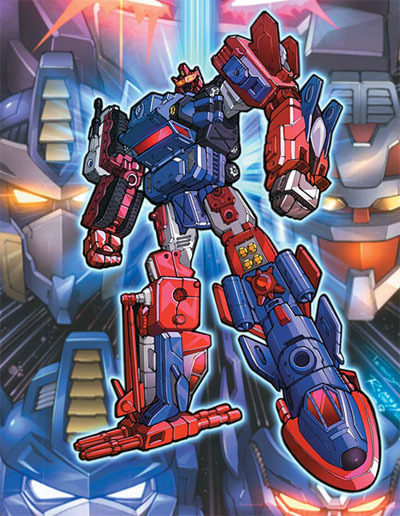

So it feels like a bit of a downgrade to me. His gun shield looks like it formed from a tank component to me, but that could be a stretch… Maybe he really IS a Duocon in this universe.
Liege Maximo

If there’s one thing Liege is known for, it’s not having a consistent design.
As we’ve gone from whatever this is supposed to be…

To Loki because the MCU was really popular back then.

The new design still uses Marvel Loki as the basis, but dials it back considerably, instead making him more of a generic knight. Notably the inclusion of a sword is interesting, as Aligned states his weapons are poisonous Legion Darts. Maximo’s initial concept painted HIM as the first Decepticon, of which Megatron and the others are descended from, an evil being created by Primus to counterbalance the first Prime via G2. Because Megatronus later inherited a lot of this, he instead was cast as more of a manipulative trickster, still evil, but not to the same extent as his G2 version was. Liege Maximo is also the Prime of false starts, as his G2 and IDW selves were set up as the next major villain but cancellation saw this unresolved. G2 Liege Maximo saw conclusion in what was unofficial fan fiction written by Furman, while IDW Liege Maximo was unceremoniously killed by Shockwave-Onyx in the main book. His only role that saw a proper conclusion was in RiD15, where he was the villain of the day in a chapter book causing problems for the Autobots because he was bored in the Prime Realm and wanted a cheap thrill. RiD is also the only place his Loki like characteristics were played around with. Because the Primes in ONE appear to all be benevolent, it’s not clear if Megatronus or Liege Maximo are still supposed to be the evil ones or not, but the more heroic looking Liege says no to me.
Amalgamous Prime

The mad lads finally made this horrifying thing work.

Pushing it into a four armed ED-209 direction is much better, and frankly going by his more “primitive” build, they can easily make future Shockwave toys into Amalgamamous. This guy’s claim to fame in the modern lore is being the first actual Transformer with the first Cog, which again is contradicted by Nexus and (possibly) Onyx also being able to Transform�� Aligned lore says his Cog informed all future robots on Cybertron of the ability to Transform, but ONE streamlines it that ALL the Primes had Cogs and the ability to Transform, making Amalgamous somewhat redundant. Aligned also claims his direct descendants are “Shifters”, Transformers with omni transformation, rather than the standard robot to vehicle.



Aligned didn’t really do much with this concept because you can’t realistically make a toy of such a thing nor is it feasible to have them as reoccurring characters for both expenses and being OP, with TFP Makeshift and RID15 Pseudo being depicted as shadow creatures in their default mode. The Shifters haven’t returned post Aligned so I think it’s an abandoned concept. Future stuff I would assume would instead say Triple Changers and Six Changers are AP’s direct descendants since they’re much easier to work with in toy and fiction. His new Robot Mode makes me think he turns into a tank, but I’m also not sure if his head is his chest or not….
Vector Prime
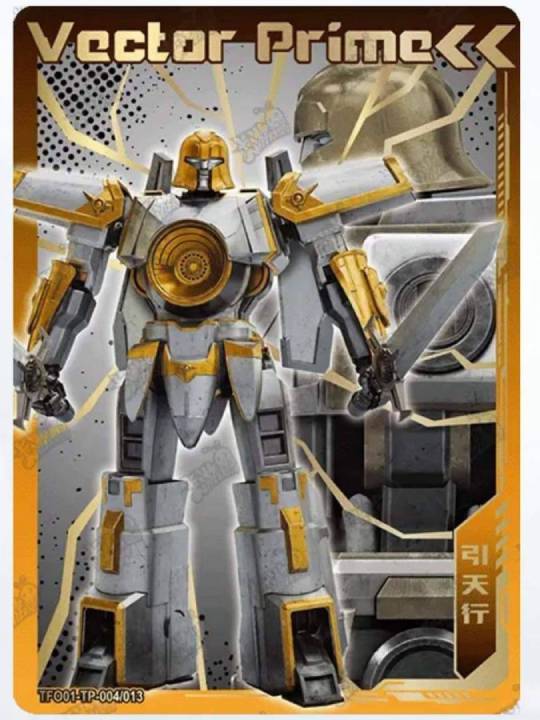
Aside from his head and colors, the TFONE version is straight up the original Galaxy Force version.

Though his colors evoke one of Vector Prime’s influences, the Marvel G1 Last Autobot.
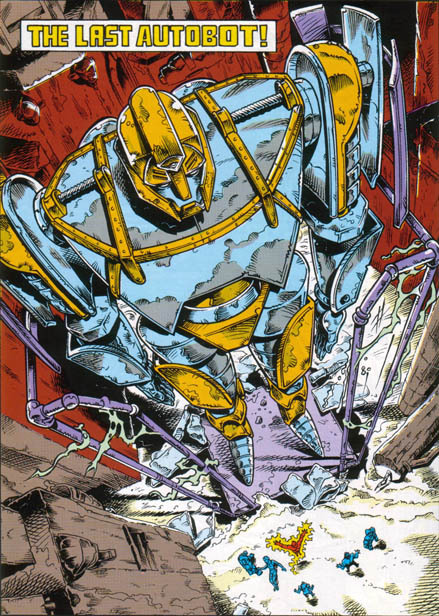
Vector Prime’s best known role is in Cybertron/Galaxy Force, where as the Primus appointed guardian of time, he joined the Autobots of the present day to find the Cyber Planet Keys to close the Black Hole that threatened the universe, as it was the end of time. Galaxy Force also showed Vector Prime can manipulate time, but it was a drain on his energy, and using it too much would kill him. Notably he used a brief display of this early on to save the kids and Mini-Cons from certain death, but I guess this version of Vector couldn’t do the same to defeat Sentinel & the Quints…
82 notes
·
View notes
Text
Banban Analysis
I think Banban's story is the most interesting part of Garten of Banban and I'm extremely excited to see how it plays out. This discussion is essentially going to breakdown what Banban is and go through some of his behavior in the first four chapters.
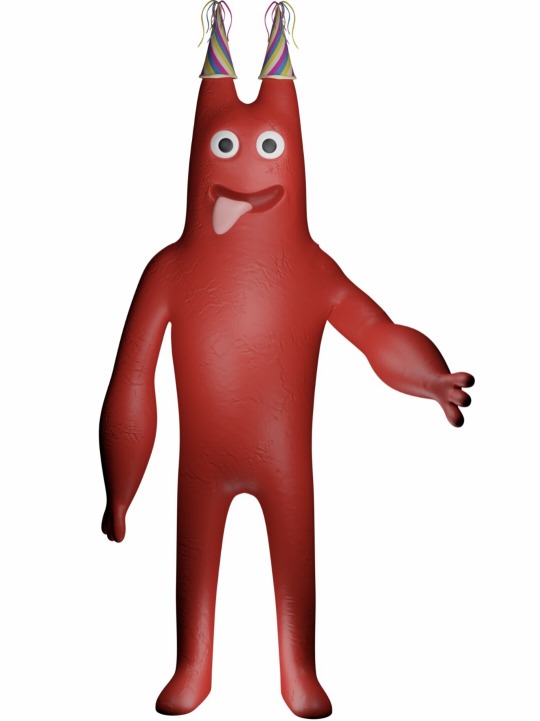
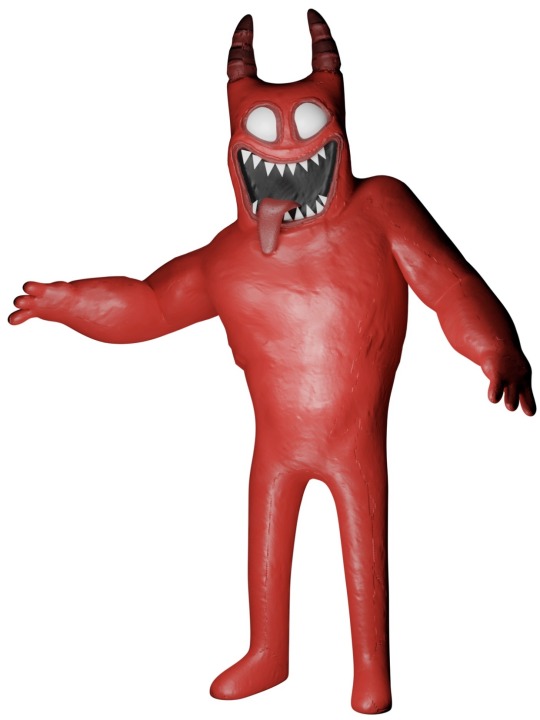
Banban is the #6 experiment created by combining human genome from one of the doctors named Uthman Adam with Givanium for the upcoming Bring-A-Friend Day.
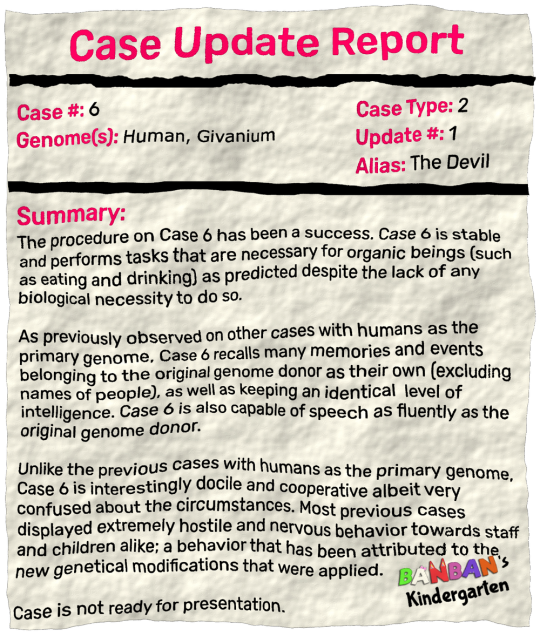
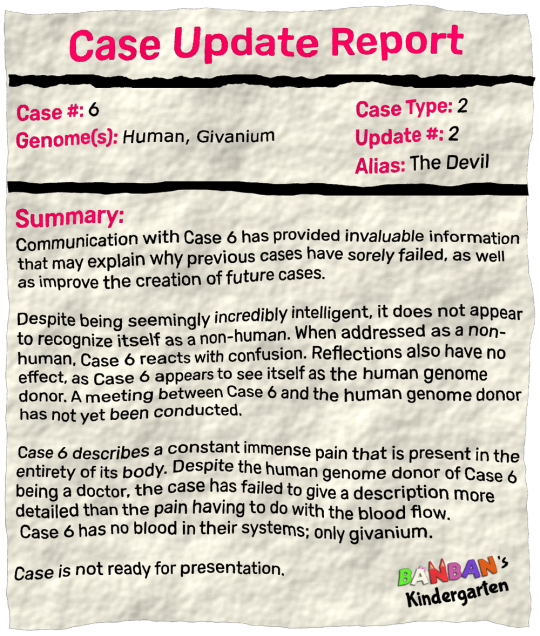
At the time Case #6 was considered a success outside one flaw. He views himself as human and as the actual Uthman Adam.
Once Case #6 and the real Uthman Adam were introduced to each other this lead to disaster.
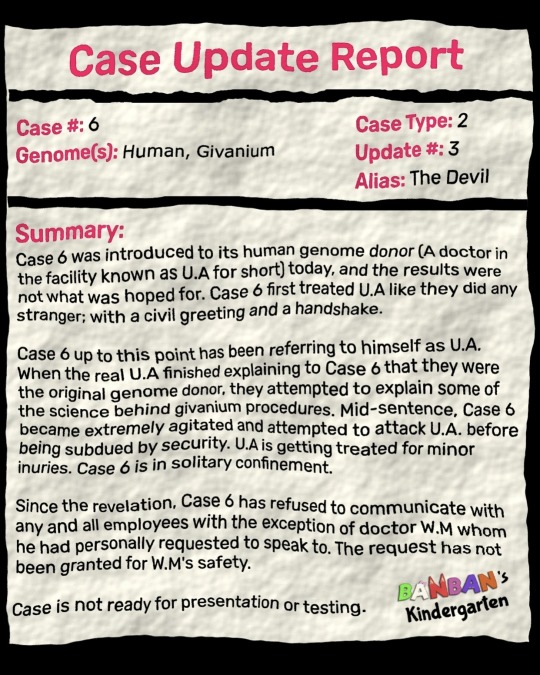
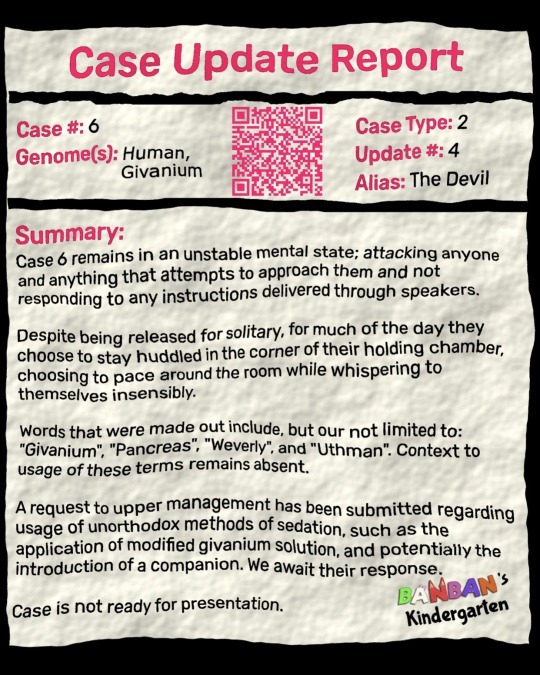
As described (in Case Report #13 Update #3) Case #6 has a complete meltdown.
Which results in two things happening:
1. Case #7 named Banbaleena is created.
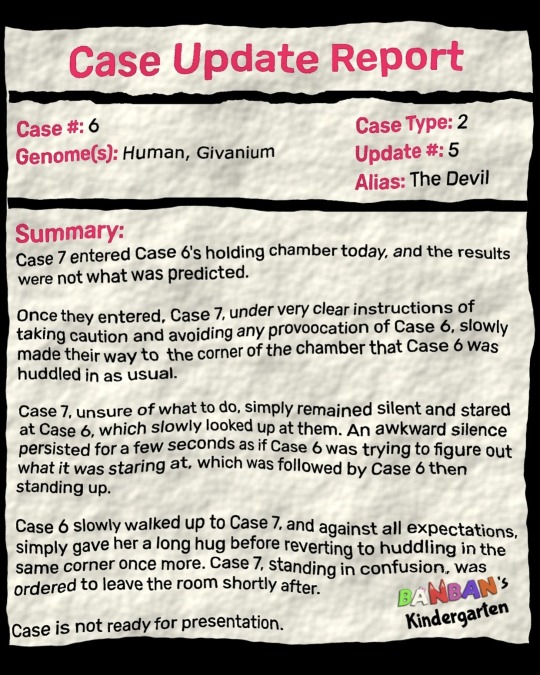
Since Dr. Weverly Mason was the only person Case #6 was willing to communicate with it's speculated her genome was used to create Banbaleena. Especially since the real Dr. Uthman and Dr. Mason are close.
While Case #6 and Banbaleena both view themself as their human genome donor only Case #6 was introduced to his.
It's unconfirmed how Case #6 perceives Banbaleena. Either as her human genome donor or something else. Regardless he recognizes something in Banbaleena resulting in their long hug.
Banbaleena helps Case #6 feel less alone however it doesn't change his disobedient and aggressive behavior.
Sidenote while this part is also speculation the parallels felt too similar to not mention:
During Chapter 3 when Case #6 has us make Nabnab a companion he say, "Nabnaleena was that solution. We had a theory that Nabnab was as aggressive as he was due to his loneliness."
While part of the reason we're creating Nabnaleena is because Nabnab is on the hunt making it too dangerous to do anything. I think since Banbaleena helped ease Case #6's loneliness that's part of the reason he has us help finish creating Nabnaleena. As a way to help Nabnab no longer feel lonely.
2. They used a newly-modified Givanium to lower Case #6's ability to self-think.
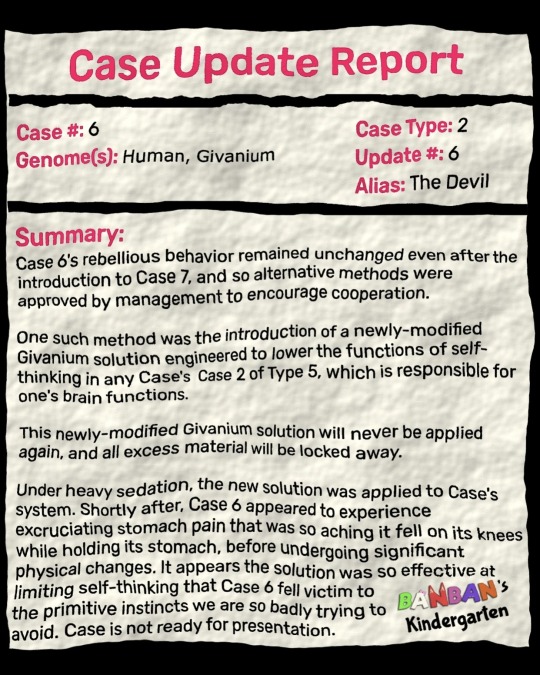
We actually witness Case #6 fall victim to his primitive instincts during one of the secret tapes in Chapter 3:
Case #6 is constantly struggling in between an internal battle Uthman Adam (who he perceives himself as) VS Banban (his violent primitive instincts).
After all it's Banban who has it's iconic quote:
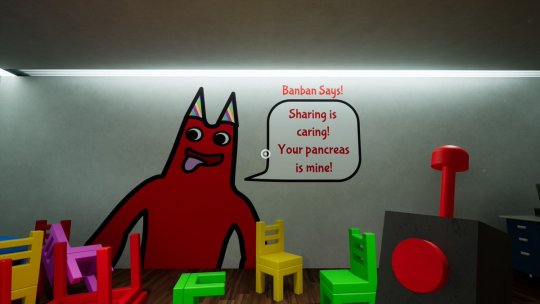
Even though Case #6 has met the actual Uthman Adam he still perceives himself as the real one.
We witness this through countless dialogue. Even during the creation of Nabnaleena this is mentioned. "We had a theory that Nabnab was as aggressive as he was due to his loneliness." Referring to himself as one of the doctors despite the fact Case #6 isn't.
The saddest example being this conversation in Chapter 4.
"I feel now is a good time to introduce ourselves, which we haven't done up to this point if you can believe it. I am Uthman. I worked here before everything came crashing down, literally and figuratively."
"My coworkers and I should've spoken up sooner. Perhaps all of this should've been prevented then. But then again, my coworkers weren't really friends in those last couple of months anyway, so it would've needed some good planning."
"You ever had those friends that suddenly turn on you for no reason? To say mine turned on me would be an understatement. They suddenly stopped talking to me. They looked at me like I was some sort of monster. Sometimes I lose my temper, sure, but it seemed excessive. I was and still am confused, to say the least."
The awful way Case #6 was treated by his "friends" could also explain his behavior in Chapter 2.
"Look, i'm sorry I hit you but you gotta understand I needed something from you that I could only get if you were unconcious and I was all out of sedatives. If you'd seen me, you wouldn't have trusted me, I know it. But there was one thing I didn't lie to you about, and that's me knowing why you're here."
I find Case #6's confusion SO INTERESTING!!! You have a character who knows others view him as a monster yet he cannot understand why. Since when Case #6 looks in a mirror he sees "himself."
While Case #6 holds all of Uthman's memories before his creation.
Who is the ACTUAL Dr. Uthman?
We have these two notes.
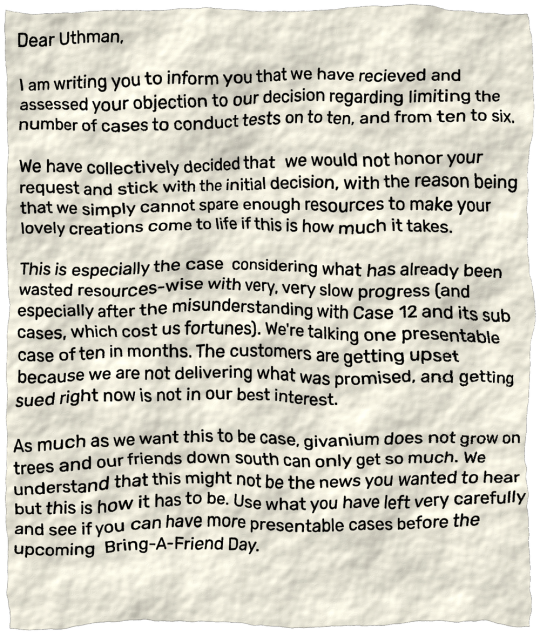
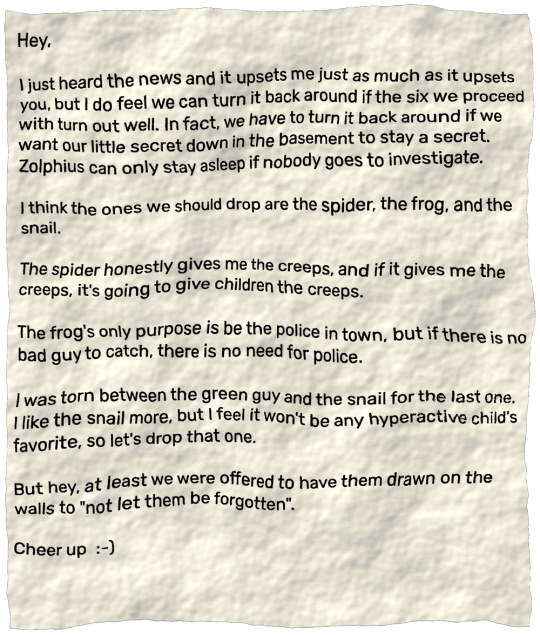
Along with one letter between Dr. Uthman and Dr. Mason discussing the ball pit which reads, "This thing can barely support the amount of children we have enrolled in the kindergarten. We're having double that tomorrow. Something really bad is going to happen, and we need to be as far away from here as humanly possibly when it does. We've been on the bad side of the wrong people for a long time, and if we're still here when everything goes down, it will be the end of both of us. If not at the hands of angry parents, then at the hands of our superiors."
"A place like this should not exist. The stuff we've witnessed here should not exist. The casualties that will result from this catastrophe will only serve the greater good; which is shutting down this place once and for all."
"I'll have a plan ready for tomorrow. now, you just pack your things."
We don't know if this plan, Bring-A-Friend Day or something else are the result of how things have turned out.
Regardless both Dr. Uthman and Dr. Mason were unable to escape. We don't know what happened to Dr. Uthman but we do know Dr. Mason is currently with our child (from the notes they've left).
Boarding passes found in Chapter 1:
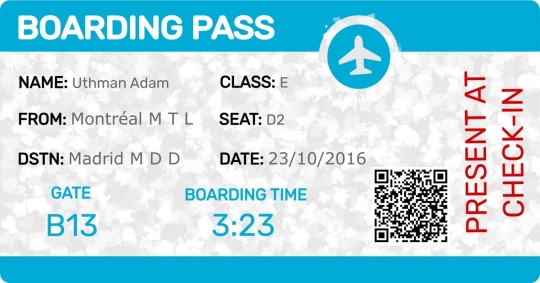
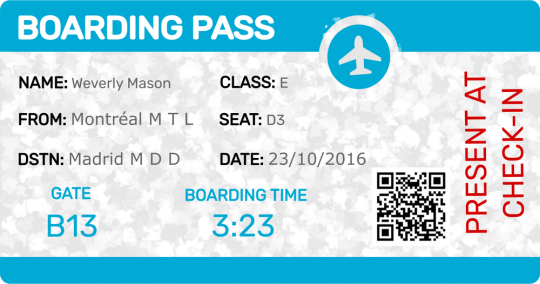
There's one MAJOR difference between the real Dr. Uthman and Case #6. Unlike the real Dr. Uthman who was prepared to abandon ship even viewing the potential disaster and casualties as something for the greater good.
Case #6 wants to help and even acknowledges, "My coworkers and I should've spoken up sooner."
While Case #6 may be hiding another ulterior motivate since he retains most memories of Uthman including knowledge of the secret down in the basement.
I think overall he's being honest with his goals mentioned in Chapter 2, "But there was one thing I didn't lie to you about, and that's me knowing why you're here. You're here for your children. I, too, am working towards saving them if you can believe it. But someone else has them. Someone far stronger than you and me both that resides deep in the abyss."
However due to the internal struggle he experiences falling into his violent primitive instincts from the newly-modified Givanium. When control is lost that alters his goals to eating our pancreas.
Case #6 is constantly having to work around himself.
For simplicity in this upcoming section I'm going to refer to regular Case #6 as Uthman and the Violent Instincts as Banban.
Chapter Two
The first Case #6 we meet is in Chapter Two is Banban.
At first tricking in the player and hitting them from behind Banban says, "Three birds with one stone!"
Note: Mr. Kabob Man the statue in Chapter 3 that imitates Banban also says the quote, "Three birds with one stone!"
"I get all of your keycards, I get the perfect specimen AND I don't have to deal with that thing down there. And it's all thanks to YOU! Oh come on, I didn't hit you THAT hard. Or maybe I did. Either way, it's best you take a nap while I prepare for our little surgery."
Despite this they also leaving us a note warning about the attack. However it reads as more of taunt to me.
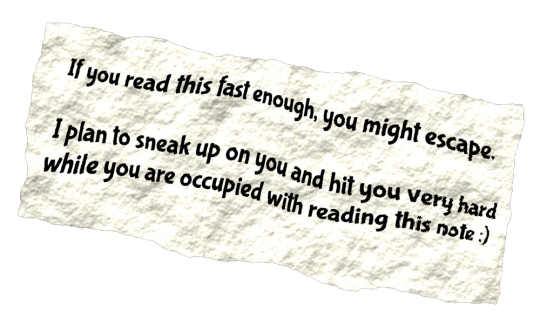
While Banban mentions a surgery and using us a specimen nothing actually happens to the player.
Uthman could’ve gained controlled but I think that Banban was possibly prepping things when we woke up earlier then expected.
Since during Banbaleena's class Banban says, "Also teachers, please keep in mind that we are on the lookout for a very, very naughty student believed to be accompanied by a drone. If you catch them, call Principal Banban’s office immediately."
Very very naughty doesn’t feel like something Uthman would call the player.
When we later reunite with Case #6 there's a glass barrier between us. We can tell this is Uthman due to his behavior. He apologizes, is upfront with his goals and informs the player of a way to escape Banbaleena and Jumbo Josh.
Chapter Three
We first encounter Uthman over the speaker system.
"Glad to see you made it! I don't know how you did it, but then again you survived a giant elevator crash so I guess I shouldn't be surprised."
"Also, again, I apologize for hitting you over the head. In fact, it is for this reason that I believe we should not meet face-to-face. You see, for whatever reason I am prone to violent instincts, and I do not trust myself to not give into them again."
"I have locked myself inside of a surveillance room. That way I can help without being a danger to you."
Uthman sticks to his word helping the player throughout the chapter. It's ONLY when brought face-to-face by Stinger Flynn that Case #6's violent instincts come out. Being drawn to the smell of the player's pancreas.
"You can run away, but the smell of your pancreas will always draw me to you . . ."
Resulting in a chase scene and eventually a fight between Jumbo Josh, Banban and Stinger Flynn.
Chapter Four
When you reunite with Uthman in the infirmary he says, "When the Queen mentioned having many new visitors in one day, I knew it had to be you. Listen, whatever happened to me . . . Whatever I tried doing to you . . . Just know it wasn't actually me. I was forced to obey without much thought. I tried communicating with you from afar for a reason. Now you know the true reason why."
"Still, I want to make it up to you. The queen filled me in on the situation with the elevator. I want to help with that. I feel much more in control now. I'll come help you find the missing pieces of the elevator. I just need to rest for a little bit and I'll meet you at whatever that station is."
Which Uthman does until a fight between him and Nabnab breaks out. Which I think is really cool considering Nabnab is his opposite. Both in name and character wise.
Despite Uthman transforming into Banban during the fight he is able to restrain himself. Not attacking us for our pancreas even though we're so close.
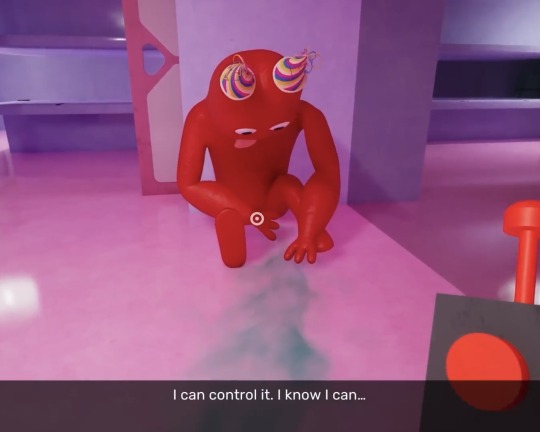
This is the final scene we see Case #6 AND I'M SOOO INVESTED IN HIS STORY AND SEEING HOW IT PLAYS OUT!!!!
Also I like how Case #6 cares deeply for some of the other experiments. Whether it's some form of kinship or out of a sense of duty believing to be partially responsbile for creating them.
Examples of this are:
When Jumbo Josh falls for one of Sheriff Toadster's trap Case #6 comments, "Poor Josh . . . I can't imagine how confusing this has all been for him . . ." Holding no resentment despite the fact they fought in Chapter 3.
In Chapter 4 Case #6 intends to hand over the imposter statue AKA Mr. Kabob Man to someone he describe as, "very close to me." (This is speculated to be Zolphius). Even commenting, "He must've gotten very lonely, but I got him a new friend."
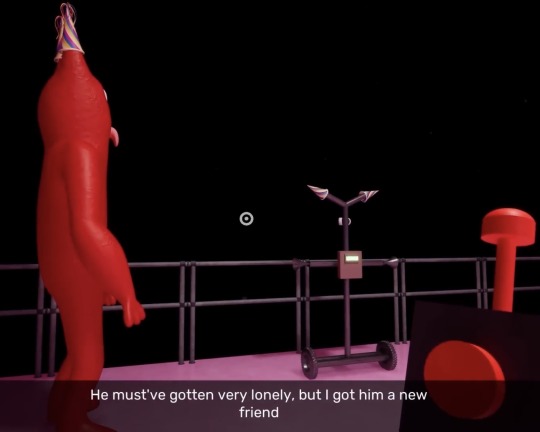
In Chapter 2 Case #6 indulges in Banbaleena’s behavior. During her class over the speaker he refers to himself as Principal Banban.
I find it interesting the non-human version acts more humane than the real Uthman.
#ANYWAY I LOVE THESE GAMES!!!! RANT OVER!!!! PLEASE ADD ONTO THIS I'D LOVE TO HEAR OTHERS THOUGHTS!!!!!!#ALSO PLEASE CORRECT ME IF I’M WRONG <3!!!!!#I LOVE THIS STUPID RED DORK!!!!!!#Garten of Banban#Banban#Long Post#Long Test#MaddyMoreauPost
461 notes
·
View notes
Text
Rayashki and Zeno: How a harsh environment shapes actions.
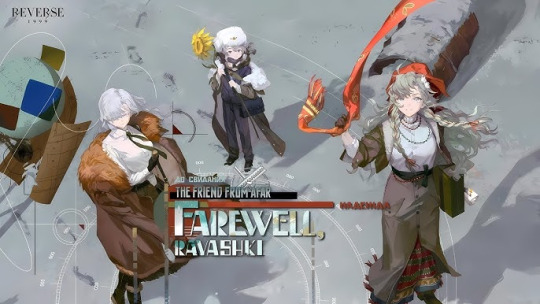
Sometimes, a perception is taken as a principle. A "cruel reality" can be described as a negative perception of the material world, used to assert a situation. "Reality is cruel", however consists in using the previously descrived perception as a fundamental truth or a proposition in which to base the foundations of a system of belief, of behaviour or of a chain of reason. Both are heavily present in Farewell Rayashki, a story all about the strenght of the colective, the indomitable human spirit in the face of adversity and what shapes the actions of those who persue a goal. With that in mind, I wanted to write... Not an analysis per se, but rather to build some sort of structure or perspective (whatever you want to call it) through which the story can be analyzed.
Now, imagine a matrix diagram where the X-axis goes from "Gemeinschaft" (Community) to "Gesellschaft" (Society), two terms taken from german sociologist, Ferdinand Tönnies, and the Y-axis goes from "Deontic" to "Epistemic" in a mix between a Gretchen McCulloch's linguistic sense and a Józef Maria Bocheński's philosophical sense. If everything I just said made no sense, don't worry. Here's a (very) rough explanation of what I'll mean with these two dichotomies through this post: X-axis: A classification of societal ties. "Gemeinschaft" refers to personal, direct interactions with emotional relationships (such as families or small towns like Rayashki) formed by people who strive to archive the goals of a collective. "Gesellschaft", on the other hand, is about indirect and formal interactions, with more rational relationships (like a company or an institution like Zeno) in which everyone band together to persue personal goals in common. Y-axis: A classification of actions as both modality (McCulloh) and authority (Bochenski). Roughly: "actions based on interpretations and beliefs done by someone with an authority based on their ammount of knowledge and experience" (Epistemic)" vs "actions based on rules and/or desires done by someone with a role or position that gives them the power to enforce them" (Deontic).
Upper-left: Gemeinschaft/Epistemic

Windsong's quest, mostly percieved as a fool's errand, is a classic underdog story. The lone reasercher who, disheartened by the lack of support from all the important academic institutions and societies, finds in the small town of Rayashki a more hospitable enviroment to persue her goals. She creats emotional conections with the community and soon finds more self-fulfilment in helping the townfolk than in other things like taking Zeno's offer or abandoning her studies, which are presented as more beneficial options from a rational point of view.
She confronts the notion of "cruel reality" and rejects "Reality is Cruel" as a principle. This action comes from what she knows (her study of ley lines) and beliefs (the people of Rayashki, the usefullness of her field of research).
Bottom-Left: Gesellschaft/Epistemic

You'll think he should be at the opposite side of Windsong BUT Bertolt, as the classical evil guy in your everyday underdog story, actually rejects the notion of "cruel reality", and accepts "Reality is Cruel" as a principle. His emotional detachment from the people of Rayashki, their values, and even their very same idea of community, comes from his role as a member of Zeno, an institution that exemplfies the impersonal and formal relationships of the Gesellschaft. He doesn't see himself as the evil corporate guy who's there to destroy their dream for a greedy goal, but as the savior who comes to provide the light of rationality to this uncultured rural people who are willing to risk their lives for the sake of primitive traditions and values. He defines himself as a "simple representative of Zeno, bound by their rules and orders, working tirelessly to help people in a world wreaked by The Storm", a description that allows him to minimize his negative perception of the reality of others while justifying operating under the principle of Reality is Cruel.
Bottom-Right: Gesellschaft/Deontic
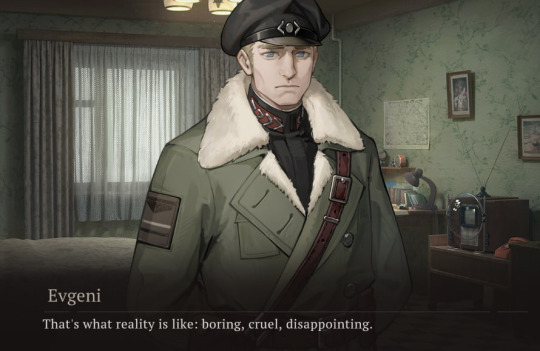
Evgeni is shown through the story as a leader of Rayashki who deeply cares about his community BUT is willing to destroy it for the sake of a rational goal: protecting the lives of the townfolk.
He embraces the notion of "cruel reality", and accepts "Reality is Cruel" as a principle.
But how is HE in the opposite side of Windsong, instead of Bertolt? In Tönnies dichotomy of Gesellschaft and Gemeinschaft, the relationships that are meant to keep people in communities and societies can also push them out: is all about wether the social ties become too tight or too lose to help us find self-fulfilment in them. Windsong found in a community what she couldn't find in society (validation and encouragment for her study of ley lines), while Evgeni thought he found in a society what he couldn't find in his community (a positive prospective for the people of Rayashki).
Upper-Right: Gemeinschaft/Deontic
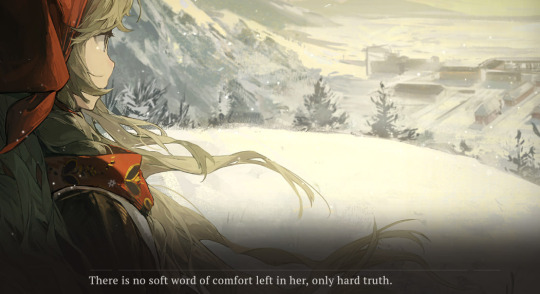
While Bertolt is a man of the world, trying to expand the benefits of globalization by placing the needs of bigger groups above those of the little ones, what Vila is persuing isn't just a goal to archive, but a dream to share. She didn't became a part of Rayashki only to build an utopia: everyone living there were already doing that and Vila found meaning in developing strong emotional ties with everyone as they strive together to work hard for Rayashki.
However, unlike Windsong, she accepts the notion of "cruel reality", even if she doesn't agree with "Reality is Cruel" as a principle. This one si a bit tricky to explain.
It all comes down to their experiences while chasing their dreams and how that shaped their understanding of what a dream is.
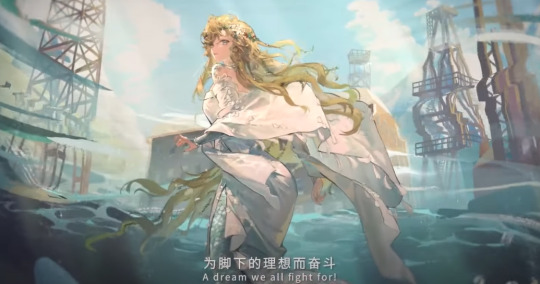
For Vila, is something that kept her going. A cherished wish that inspired her to leave the rusalki and search for a new home. A goal she could share with the people of Rayashki. A hope to cling unto while she nourishes the sprouts of Rayashki while they are passengers of the ship called "St Pavlov's Foundation" while adrift in the vast sea of the outside world, so they can carry on the spirit of Rayashki. She accepts the "cruel reality" as something that could hinder her dreams, force her to adapt them, but never crush them.
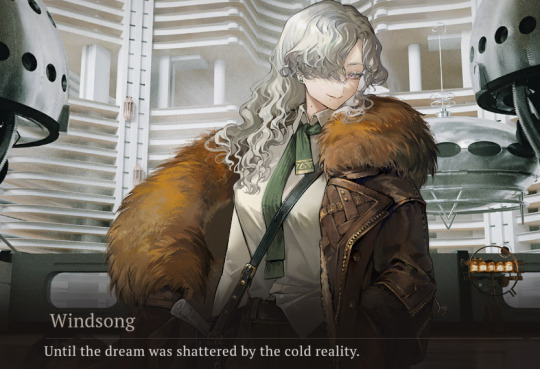
For Windsong, the dream was but a promise turned into a burden. It was not something that comforted her if held tight, but rather something it pained her to let go. Accepting the "cruel reality" meant letting something die, and for someone who was struggling in all fronts, it meant taking a toll way to big for her to handle.
As the last ley line hunter, the dream is but a gamble turned into an investment. The chance of failure is there no matter what. Only thing she can do, is to work hard to reduce it as much as possible. To her, a "cruel reality" is something that crushes dreams. Is not enough to reject the use of this perception as a principle: her own experiences taught her that the perception itself can be a cancer. She might have a tendency to put herself down, to have doubts on what she does and to even be "realistic" in any situation she encounters. But there's ALWAYS a part of her fighting her perception of reality from turning into a negative one even if she lacks the proper arguments or mental state to do it effectively. Vila noticed that from day one, and began to slowly share with her the tools Windsong lacked, helping her become a more confident and capable person, while inadvertibly gaining a trusty partner to rely on.
Their experiences shaped them into people who complement each other incredibly well. Leaning into each other, they'll plant their seeds of hope into a new generation. For the study of ley lines; for Rayashki; for those who live in a world affected by The Storm; for those who'll survive it. *** To anyone who'll read this... whatever the hell it was till the end, thank you for time! Feel free ask me anything, correct me, chew this to bits with your bare teeth, whatever you like. I just haphazardly wrote it because I love this game so much.
#reverse 1999#r1999#bluepoch#vila#windsong#farewell rayashki#gacha#ferdinand tonnies#Józef Maria Bocheński#Gretchen McCulloch#evgeni#bertolt#rusia#reverse: 1999#spoilers#r1999 spoilers#farewell rayashki spoilers#reverse 1999 spoilers#reverse: 1999 spoilers
82 notes
·
View notes
Text
An allergy to the Prequels
While I'm putting together a post about the evolution Lucasfilm's transmedia strategies, this part kinda turned into its own thing!
So I'm not sure if anyone else noticed, but, uh... there hasn't been that much Prequel content since the Disney sale, right?
'Couple novels and comics, some episodes... but nothing meaningful.
The more I look into it, the more it feels like a deliberate avoidance to touch on anything Prequel-related - beyond the required quota, that is - to a point where they'd rather tell stories set during periods that are Prequel-adjacent (Dark Times, High Republic) than something set around Episodes I, II and III.

On-screen policy: "pretend they never happened"
I mean, this one's no secret. When The Force Awakens had been announced, with J.J. Abrams at the helm, everyone sighed in relief. "Finally, George Lucas won't keep ruining the franchise."
When Abrams had been announced as the director of Episode VII, I remember this cringey animated video started circulating online, titled "4 Rules To Make Star Wars Great Again" or "Dear JJ Abrams":
“Star Wars isn’t shiny and clean... Star Wars is a western.”
If you ask me, those two things are not mutually exclusive.
'Cause Star Wars has always been both, for many Prequel kids. Both clean and dusty, Coruscant and Tatooine. There was never a disconnect between the Original Trilogy (OT) and the Prequel Trilogy.
Even the documentary The People vs George Lucas shows Prequel-hating fans begrudgingly admit their kids felt all six episodes tied seamlessly.
Abrams, on the other hand, said: "I think [the "Dear JJ" video] was right on." Later on, he also said:
he considered "putting Jar Jar Binks's bones in the desert" on Jakku, somewhere, and
he intentionally made the lightsaber fights "rougher", "primitive" and "more powerful" unlike the fast-paced ones in the Prequels.
Later, we found out he wanted to blow up Coruscant.
It's clear he wasn't a big fan of the Prequels.
But y'know what? Not many fans over 20 were, at the time. And when The Force Awakens came out, most them celebrated it as a wonderful love letter to the OT.
Star Wars is cool again. Mission accomplished 🙌 !

However movies keep coming out, and references to the Prequels - if there are any - are literally just that... references.
Sometimes in the shape of a cameo ("hey look, Genevieve O'Reilly from the Ep. III deleted scenes is playing Mon Mothma again!")
Sometimes in a name (Luke name-dropped "Darth Sidious"!)
But nothing set during the Prequel era, and nothing treating the events that happened in that period as relevant or impactful, beyond subtextual nods.
In fact, the trend of avoiding anything Prequel-related continues as the final film in the Skywalker Saga comes out:

The Rise of Skywalker has a secret Sith society that chants the name "Palpatine" instead of his Sith name "Darth Sidious",
the film pretends the Kaminoans never existed,
and neither TROS nor Trevorrow's Duel of the Fates script even try to bring Hayden Christensen's Anakin Skywalker back on screen. Let that sink in, we're talking about the Chosen One, Skywalker Senior, whose sins caused this whole mess... and his name isn't even uttered once in the final chapter of what Disney dubbed the *Skywalker* Saga (or the entire Sequel trilogy, for that matter).
But hey, The Clone Wars got renewed for one last Season! That's cool right? So many stories had gone unfinished and somehow the animation looks even better than befo--
-- oh. It's not 22 episodes? Only 12?
Four of which had already been shown to us, but hey! We need to set-up the Bad Batch series, so let's shoehorn those episodes in there, and forget Son of Dathomir, Dark Disciple or Crystal Crisis.
*sigh* Better than nothing, I guess.

In other mediums: "just not a priority"
Now this is something that I'll explore more in the transmedia post (and purely my interpretation), but the noticeable change between Lucasfilm's transmedia strategy *post-ROTS* and the one post-Disney sale is that:
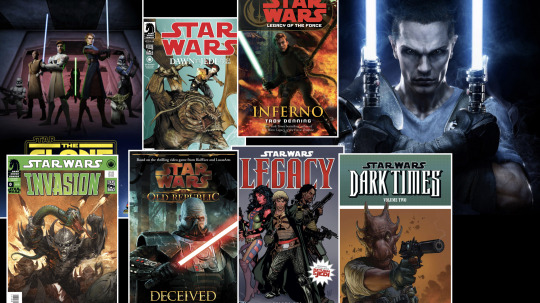
Before, the games, comics and novels were the main content. After all, Revenge of the Sith had been released, so that was it, for the movies. Thus, a variety of other content was being cranked out to keep the Star Wars franchise relevant. There were comics set 100 years after Episode 6, comics set 25,000 years prior, games set in the Old Republic era, other stories in the New Republic era, novels galore, a couple of parody films and an animated show, The Clone Wars, which sometimes received its own tie-in comics, novels and games.
After the sale and ever since, most of the transmedia products have had only one goal: promoting the films & streaming shows.
So while in 2015 you won't see an abundance of Prequel content... you'll see an avalanche of OT books and comics come out.
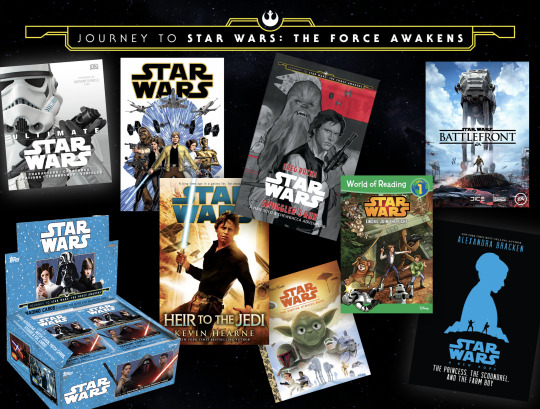
Why? Because the heroes of that era will be in the Sequel Trilogy movies. It provided context to the kids who hadn't seen the OT yet, and reintroduced those films to a new generation of fans, while priming them for the Sequels.
A multimedia marketing strategy that ultimately proved successful.
However, it continued even after The Force Awakens came out.
Don't believe me? Compare how many comics there have been set during the Prequel era vs the OT era.
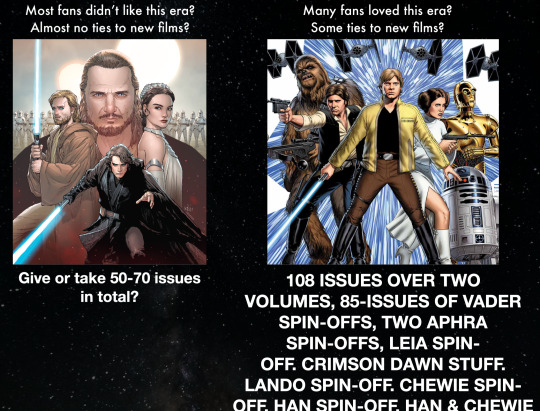
If they make comics about the Prequels, they're limited runs.
Case in point: before the current Yoda series, the best any Disney Prequel-set comic series ever got was 6 issues.
Note: it's worth pointing out that the frequency of mini-series aren't just a Star Wars-specific thing, it's a comic book industry thing. The readership for comics is dwindling, many people are reading scans online, and so no publisher wants to commit to a story that lasts more than 4-6 issues. My problem is: there absolutely would be readership for a Prequel comic series to warrant an extended run instead of a mini-series.
Let's talk books. There have been give or 64 canon novels published since the Disney sale.
Only 11 of them are set during the Prequel era. And even those stories only came out when the planets were aligned.
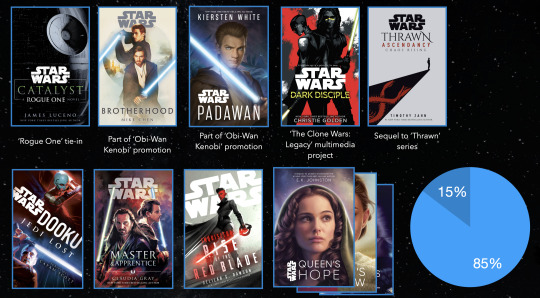
Almost half of them were released while being a part of some bigger multimedia push.
Example:
Before the Obi-Wan Kenobi series was being released on Disney Plus, we'd had one novel and like two comic stories about him during the Prequels... released between 2012 and end 2021. That's about three pieces of content in almost ten years.
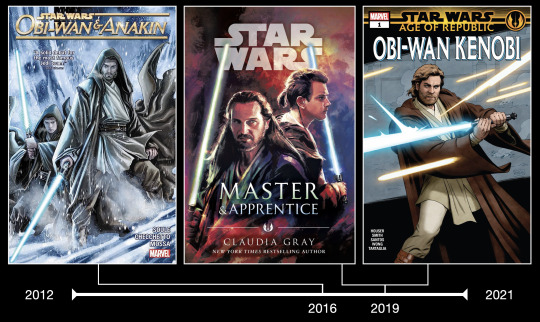
Clearly a low frequency.
Then, when the series is around the corner, two books and a comic story comes out in the space of months, plus an anthology book with an alt cover with his face on it and a comic with a story of him and Anakin in the first issue, all in 2022.
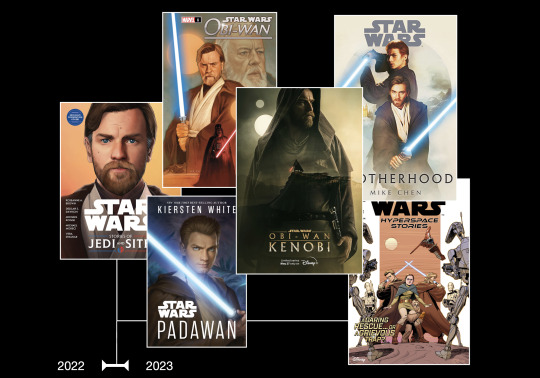
My takeaway: short of there being a film or series that needs to be promoted, you'll rarely get any Prequel comics or books.
And this is OBI-WAN we're talking about. The character who even the Prequel haters love. Imagine how little attention the other ones get.
Gaming-wise, Battlefront had no Prequel content at all (again, 2015 was the year where OT content was shoved down the consumer's throats to prep them for Episode VII), and Battlefront 2 only released Prequel content a full year later.
All that being said, we did seen some Prequel elements here and there. After all, some actors got to reprise their roles, books and comics came out featuring Prequel characters... but there's a catch.
The stories they appear in are set in-between Episodes III and IV, a time-period known as "the Dark Times" or the "Imperial era".

"Dark Times" being used instead of the Prequel era
It's easy to see the appeal of this era. You keep the same threat from the Original Trilogy - the Empire - but redress it with Prequel elements... while also cherry-picking the best characters of both the OT and the Prequels and giving them a chance to shine again.
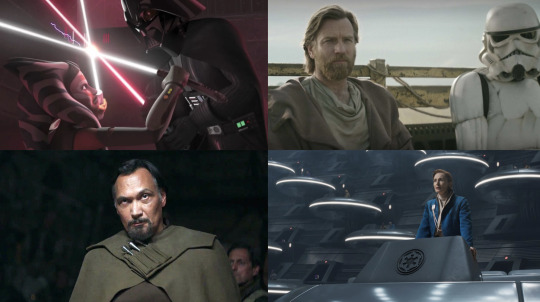
The situation is more clear cut, as opposed to the complex one in the Prequels. Bad guys are stormtroopers, good guys are anyone else. And the stories no longer take place in the shiny capital, you're back on the frontier.
But at this point... it feels like a cop-out.
When you consider how much content has been set during the Dark Times, it's nothing to sneeze at. Since the sale, we've had:
2 movies (Solo, Rogue One)
4 series set in that time-period (namely The Bad Batch, Obi-Wan Kenobi, Andor, and Star Wars: Rebels).
2 video-games (Jedi: Fallen Order and Jedi: Survivor).
17 novels (such as Ahsoka, Lords of the Sith, the new Thrawn books, etc)
And just a whole bunch of comic book series & mini-series (like Kanan, Princess Leia, various Vader-centric comics including Darth Vader: Lord of the Sith, many tie-in mini-series promoting Rogue One, Jedi: Fallen Order, Obi-Wan Kenobi, etc).

There's been so much content made for this time-period that it feels like an unwillingness to do the work and create something set something during the Prequel era, let alone something that follows its Jedi.
After all, why make a story set in the Prequels (disliked by vocal fans) when you can just take the characters in that story and put them in an OT setting (which will appease the Prequel-haters)?
Maybe these stories get relegated to the Dark Times because:
there seems to be a perception that anything set in the Prequel era won't sell?
or maybe the current SW writers weren't fond of Episodes I, II and III, and don't find those Jedi characters likable, thinking they're too righteous and dogmatic which makes it hard to craft a story around them.
Or maybe it's because they're under the impression that the Prequel Jedi are bad. Like, canonically, in the narrative. Not just in a "I don't like them" sense, but also in a "the story is all about them becoming corrupted" sense.
Let's expand on that last point.

Retconning the Prequels as the "Fall of the Jedi" era
Somehow the rare stories set during the Prequels that we do get seem to automatically be about how "the Jedi lost their way/failed".
The series Tales of the Jedi is explicit about it...
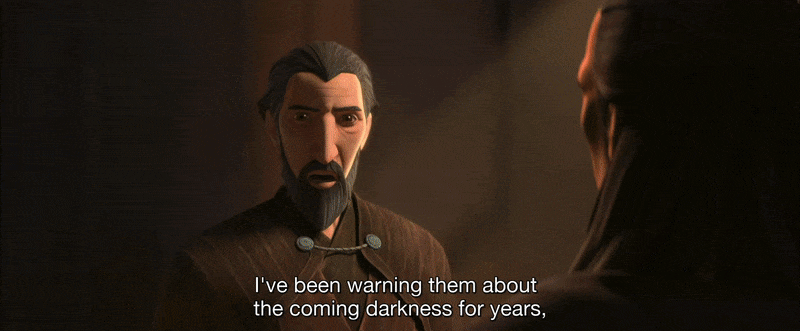
... and I already explained why it contradicts what George Lucas established here and here.
You also see it in Rebels and the new season of The Clone Wars...
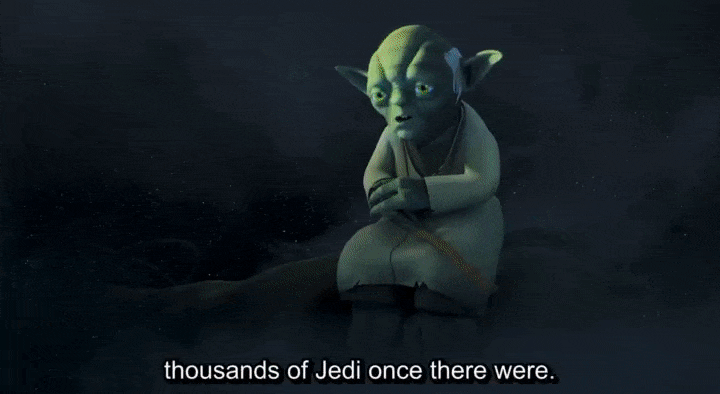

... in comics...
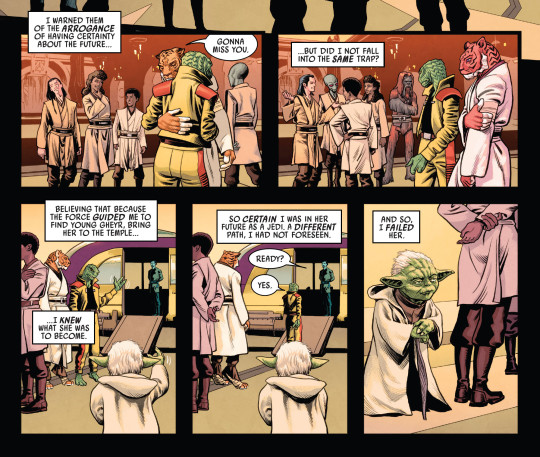
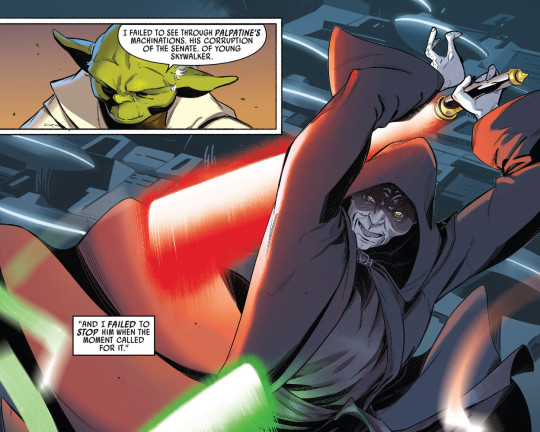
... in games...
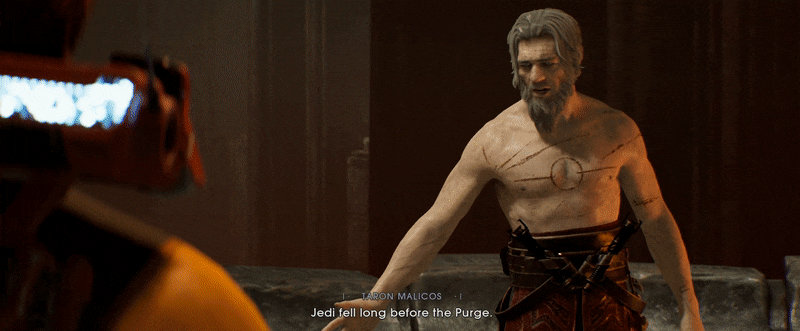
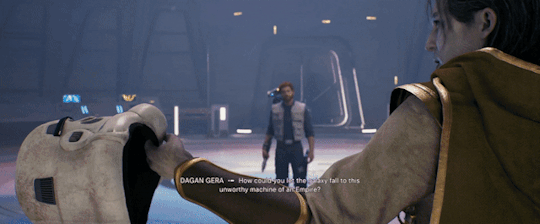
It gets to a point where the Prequels era has now been redubbed the "Fall of the Jedi" era by Lucasfilm.
You wanna know what that period was referred to before the Disney sale? The "Rise of the Empire" Era.
Because - and I'll never get tired of saying this cuz it's factual - the Prequels aren't about the fall of the Jedi, they're about the fall of the Republic and Anakin, and rise of the Empire and Vader.
So in addition to being overdone, the "Jedi lost their way" is not even the intended narrative of the Prequels (if one puts any stock in Lucas' words). It's a minor subplot at best, hardly the focus of the films, let alone a whole time period.
But dubbing it "Fall of the Jedi" implies that there's another era in which the Jedi were in their heyday.
Because Star Wars authors are in luck! Yet another alternative has presented itself in the shape of a new transmedia initiative, and it's even better than the "let's set it during the Dark Times" solution:

A new transmedia initiative: The High Republic
You wanna deal with the Jedi before the Empire, but for some reason you wanna avoid dealing with the ones seen in the Prequels?
Look no further. Meet the Jedi of the High Republic.
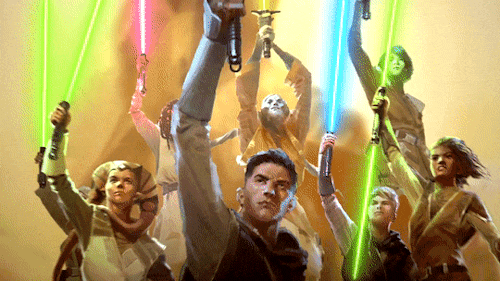
Noble, adventurous, inspired by the Knights of the Round Table, they're everything the OT kids dreamed about when they heard ol' Ben Kenobi talk about the Knights of the Old Republic.
That's more like it!
Note: the High Republic was created for other reasons and has many more upsides than the ones mentioned above. Namely, a fresh new spot in the timeline that allows for creative freedom and a beautifully-coordinated transmedia storytelling effort where retcons are non-existent. However it does seem evident that not having to deal with the 'unlikable' Prequel Jedi and their "fall" is one of those upsides.
Another perk that the High Republic era offers is more freedom in terms of storytelling compared to the Prequels.
In 2016, Pablo Hidalgo tweeted he still quotes to authors the following excerpt of West End Games' guide for aspiring Star Wars writers, from 1994.

You can't write "this was the best day in Luke Skywalker's life", for example, because another author may want to write a better day than the one you just wrote.
My guess is that a similar approach applies to how all characters from the movies are treated. They're massively iconic. So you can't write a book that drastically changes how Mace or Yoda or Obi-Wan are perceived overall.
The stories need to be self-contained, disregardable if necessary, because you'll have dozens of writers coming up with new stories for those same characters, and you need to leave them some room.
Examples:
Notice how in the book Dooku: Jedi Lost we never see how Dooku turns to the Dark Side and joins the Sith.
Same goes for crossover comic book arcs of the Star Wars issues, like Vader Down or Crimson Reign... the characters don't really change by much in those comics. You could stick to just watching the movies and you wouldn't really miss anything.
But with The High Republic, you indeed can develop these characters as much as you want.
All stories featuring Avar Kriss leave an impact on her, you can nail down who she is perfectly in one book or one comic arc, both being just as meaningful to her character.
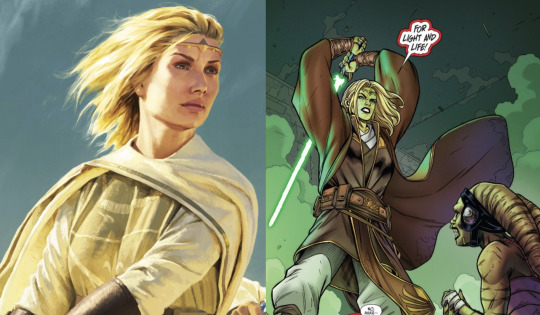
The fact that she's not as iconic/famous a character as Mace Windu means that authors can go to town on crafting an interesting and nuanced character arc for her that'll have a beginning, middle and end... something Mace will never really get.

CONCLUSION:
Back in 2015... let's not kid ourselves. The Prequels were unpopular and Disney is a multi-billion dollar corporation. Opting to make as much money as possible is what they do.
It's the same reason they decided not to go with George Lucas' original plans for the Sequels, in 2012.
I mean, imagine you're Disney. You just dropped 4 billion dollars, with a B, on this franchise. Your next Star Wars movie needs to be worth the price tag. Now, you can pick between two options:
Option #1 is uncharted territory and it explores the midi-chlorians (the cursed word…!) and the guy who presented you with this option also openly admits that a big chunk of customers won’t like it, but he wants this to be done because it’s his vision.

Option #2 is very simple: a soft reboot, that plays on nostalgia that the same chunk of customers (aka the 'boomer and Gen-X fans who grew up with the Original Trilogy and now have kids, grandkids and MONEY) will like.
It's a no-brainer. They gave the customers what they wanted.
But time has passed, the fans who were children when the Prequels first came out have grown up, and grew up with characters like Yoda, Mace, Plo Koon, Kit Fisto and other Jedi as their heroes, aside from main characters like Anakin and Obi-Wan and Ahsoka.
Can we maybe expand on them, flesh them out more?
No, let's either ignoring the storytelling potential of these characters or reducing it to them being "righteous, arrogant and dogmatic".
God forbid we get a story showing the Prequel Jedi in a *gasp* more positive light? One where their POV is more understandable, instead of the same old "we brought this on ourselves" storyline.
There's a whole decade between The Phantom Menace and Attack of the Clones... you're telling me there's no space to show us Anakin's training and how he formed bonds with the Jedi we later see in The Clone Wars? I tried my hand at it here:
Interesting or fun Prequel-set ideas from other pro-Jedi fans on Tumblr can be found here, here and here.
And y'know, part of the Star Wars intent is for fans to take the ideas in the movies and come up with their own stories. You're supposed to create headcanons.
What I'm saying is fans of the Prequels are being given less "imagination food" than the rest, and many of us who like the Jedi in particular are forced to rely on headcanons only. "Better than nothing" is no longer an acceptable standard.
There's a range of recognizable Jedi characters that have already been established in films and TCW, can we maybe expand on them, flesh them out more, instead of whole new ones?
#jedi order#star wars#sw meta#long post#meta#lucasfilm#star wars prequels#prequel trilogy#sw prequels#high republic#the high republic#dark times#imperial era#the clone wars#tcw#sw negativity
357 notes
·
View notes
Note
🌬️✨ Blowing kisses to you and your posts 💗
I would like you, if you can, to explain a question: I see people saying that Mars rules celibacy, What could you comment about it? There would be specific houses/signs that would reinforce this?
Mars is the soldier. While its naturally aggressive and fierce as a planet, it is carnal not sensual.
the difference between the two is that the carnal urge is a primitive. animalistic instinct hardwired into us through years of evolution.
sensuality is slow, builds with time and is pleasure seeking and indulgent.
carnality is raw, fierce and seeks immediate gratification. its a "need" or an "urge".
How would one describe a soldier? they're concerned with doing their duty but there is also a sense of urgency and immediacy to what they do bc in the warzone everything is very do or die (literally). this is the martian approach to sex. its the distinction between fucking and making love. (mars vs venus)
however this means Martian natives have a far more simple minded approach to sex. animals don't think too much, they just do what they're supposed to do. this is how soldiers are encouraged to be like as well. not to think but to act.
However, despite all this, Mars is not hypersexual. their approach to sex might be aggressive or intense but they themselves are not promiscuous.
we need to understand that celibacy in the vedic context refers largely to someone who is unmarried although it can refer to prolonged abstinence as well (more rarely). mars may be into primitive aggressive sex (this depends on placement, aspects etc as well) but Mars most definitely will not rush into marriage because of sex. In this context, we can understand that Mars is "celibate" not due to asexuality but in fact, its the opposite. they're not the type to rush into anything, although the stereotypes present them as being impulsive. they're only impulsive with the special someone they've chosen.
mars in scorpio is an extremely sexual placement. although id rather not rank placements, i truly think this is one of THE most freaky, sexy placements. scorpio is ruled by mars for a reason👀 and by nature both scorpio and mars makes a native very picky with their partners and very selective with who they see romantically. but with that one person, they'll go batshit crazy.
mars in 8h again reinforces this nature. someone with a lot of 8h placements or luminaries in 8h will also be highly sexual but not promiscuous. 1h placement can also do this.
74 notes
·
View notes
Text

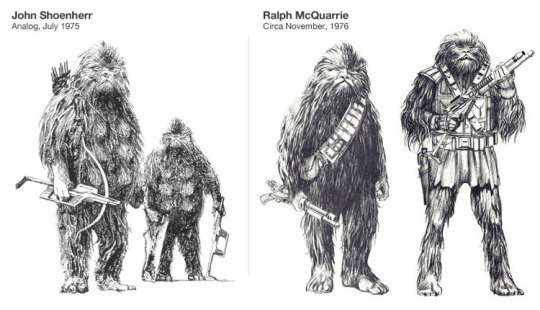

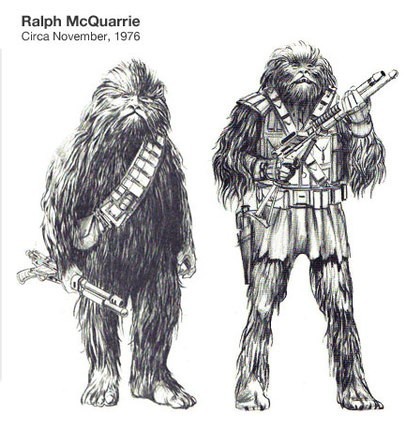
APPARENTLY, CHEWIE'S CREATION WASN'T AS ORIGINAL AS WE'VE ALL BEEN LED TO BELIEVE.
PIC(S) INFO: Spotlight on cover art to "ANALOG" science fiction magazine (cover dated July 1975), and the big, furry, ape/dog-like beings that inspired Chewbacca's final look. Artwork by John Schoenherr.
PIC(S) #2, 3, & 4 INFO: John Schoenherr's creature compared with Ralph McQuarries redesign of Chewbacca, from "The Art of STAR WARS," page 67.
OVERVIEW: "Enter John Schoenherr Stage Right:
RALPH MCQUARRIE: "George also gave me a drawing he liked from a 1930s illustrator of science fiction that showed a big, apelike, furry beast with a row of female breasts down its chest. So I took the breasts off and added a bandolier and ammunition and weapons, and changed its face so it looked somewhat more like the final character, and I left it at that."
As is obvious from the following side-by-side comparison, the illustration McQuarrie is referring to wasn’t decades old, but months, being none other than this one by "Dune" legend John Schoenherr, from the July 1975 issue of "Analog."
Hmmm.
The drawing, as the cover, was for a Hugo-nominated novelette by George R.R. Martin which: "[…] deals with the “realities of a very rigid society conflicting with what looks like a pushover primitive tribal society; and we find out where the strength really lies. It’s called "And Seven Times Never Kill Man" (drawing its title from a "Jungle Book" poem by Rudyard Kipling).” A story which in itself is pretty familiar to the nature vs machine conflict surfaced in the early scripts and again in "Return of the Jedi" (although that's a theme so common by then that it's hard to say that this particular story had any explicit influence on 1977's "STAR WARS.""
-- KITBASHED (blogspot)
Source: https://kitbashed.com/blog/chewbacca.
#STAR WARS#Chewbacca#Concept Art#Sci-fi Art#Sci-fi#Sci-fi fantasy#Chewie#70s Sci-fi#70s Sci-fi Art#Vintage Sci-fi#Chewbacca Chewie#Wookie Species#Wookie#Analog Magazine#Analog#Original Trilogy#Ralph McQuarrie#The Art of STAR WARS#STAR WARS 1977#Cover Art#Magazine#Magazines#Sketch Art#Super Seventies#Wookies#Ralph McQuarrie Art#John Schoenherr#John Schoenherr Art#Science fiction#Sci-fi Fri
14 notes
·
View notes
Text
I watched this documentary series on the making of Creation of the Gods. These are just my reactions to it and not a synopsis.
Episode 1
It's cool seeing just how many people were involved in the making of this movie(s)
The writer Ran Jia'nan was saying that they had to cut out stuff from the story that might not have made sense (to a wider audience) or perhaps was not so relevant to the main plot, and the example she used was that when Ji Chang threw up the bits of Bo Yikao that he had eaten, those pieces became rabbits. After a long time of mulling it over they decided to cut that from the story.
The actors had to learn to ride horses, combat, archery.
Training montage!!!!!
Most of those chosen had not performed professionally so they needed to train in acting and performing too.
Their first lesson was in drums. Not sure how to put it into words, but basically the teacher said that drums are an instrument that can match our pulse, and that in battle, the rhythm at which we fight is the rhythm of our pulse. That's kind of hype, they look cool.
Second lesson was combat but they also had to work out a lot too.
Third lesson was horseback riding.
Rad that one of their trainers is like, a cowboy lol.
Not only did they train in horse riding, but horse riding while fighting.
Fourth lesson was culture/history class, including a classical Chinese education. Probably to give them a deeper appreciation and understanding of the characters and story.
Wuershan was more focused on whether the actors could relate to their characters.
Ji Fa's clothes look so good.
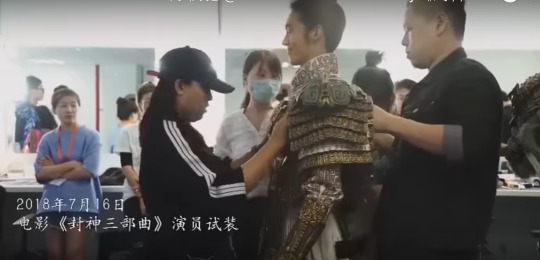

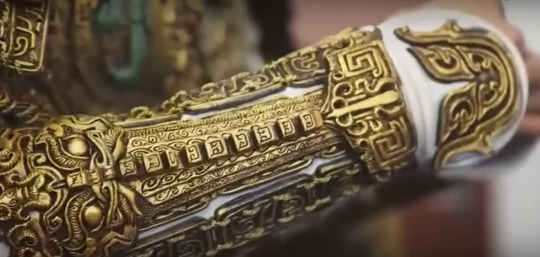
The scenes when Ji Fa was riding back home in the end of the first movie were filmed in Xinjiang. Those scenes were sooo good.
I appreciate that Wuershan wanted a very foxlike Daji and had Naran study fox behaviour. She watched fox videos but also went to the zoo to watch foxes :3
Speaking of Naran, I think she trained to be fluent in Mandarin for this movie which is so amazing :3
Daji's appearance right after she is possessed by the demon is so...wow. The long hair, the flowing robes. She didn't die in those clothes, but as the fox it's like, a little primitive. She's wearing very basic robes. She is not the original Daji, that's for sure.
The guys pumping in preparation for the dance scene :P
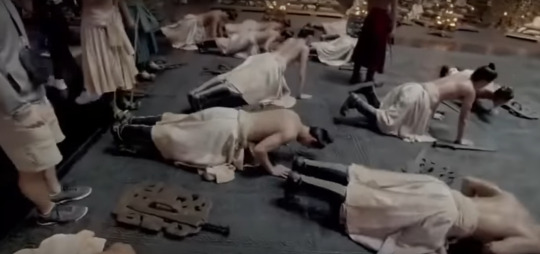
The dance performance was shot in one go! :3
They're literally rewatching and admiring their muscles here lol

Episode 2
The concept art is so cool. Wuershan emphasized the good vs evil battle so the one with the very clear yin-yang outline probably emphasized that the best.
The process by which they decided on the aesthetic for this movie series was interesting. Investiture of the Gods is based on a very ancient time, but the novel itself was written in the Ming Dynasty. Add to that the mythical elements that should in theory transcend time. What do you get? In the end, they went for a 70% 水陸畫 style (which is an artistic style and not a time period) and 30% 殷商 (which refers to the Yin and Shang dynasties), plus a bit of Song Dynasty 山水 art style (which I guess is referring to that style of landscape/nature art).
Wuershan really liked a mural that was in Yongle Gong and wanted the aesthetics of the movie to emulate that style.
Concept art for the outfits. According to Wuershan, in the Shang Dynasty, white was considered a regal colour.
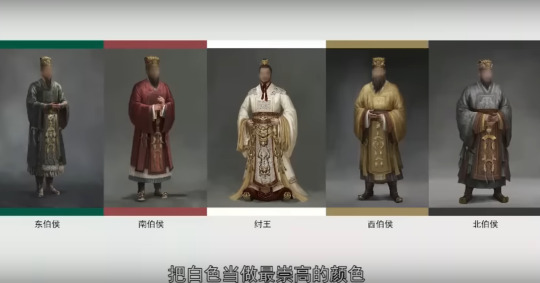
Empress Jiang and her family were from the east, by the ocean, so that was why they wore blue.

The duke from the south was thought to have come from a hot place, so that was why he wore red robes.
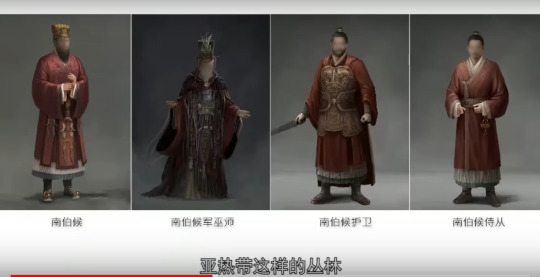
The northerners wore gray, as their lands were thought to be kind of...vast and gray.
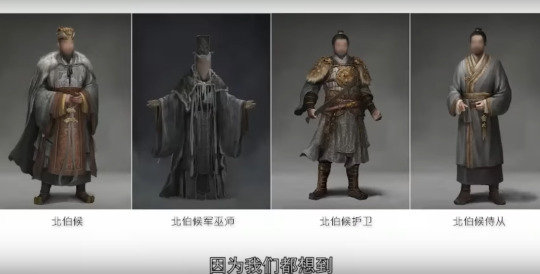
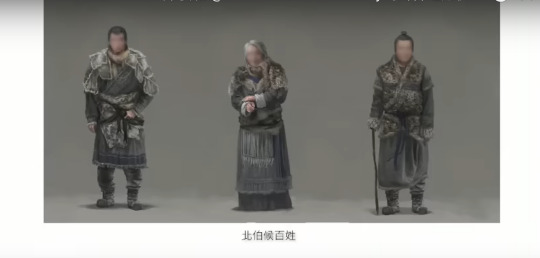
Then lastly the folks from the west, including Ji Chang, wore yellow, though here of course it looks more like a muted yellow, a brown. Anything too bright and it would remind people too much of an emperor.
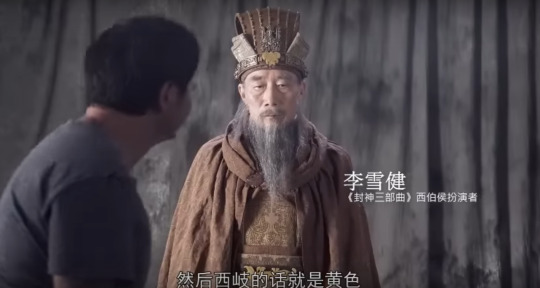
So the team put effort into fleshing out the world, even though we only saw a bit of it (at least in the first movie). But it kind of shows how ambitious Wuershan is about making this an "epic" movie series, not in the sense that it's super great, but in the sense that this is a big world with a lot going on. Even though this movie wasn't even that long, I did feel that sense of magnitude, that there were a lot of things going on even if we were just focused on the top.
Bo Yikao <3

Hell yeah Yang Jian in front of the blue screen
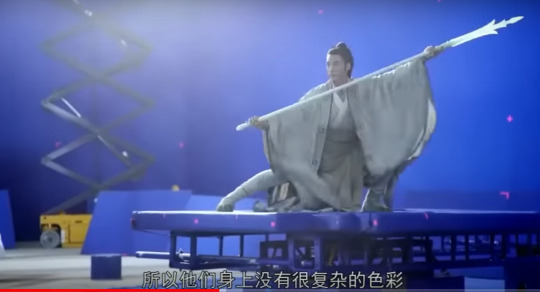
It's interesting that Wuershan is so involved in every aspect of the movie. He was discussing clothing materials with Tim Yip. He is the director, but I think he's just really passionate about the world he's building and he wants it to be as immersive as possible.
Naran's interpretations of her outfits was interesting. When she was still the real Su Daji, she was dressed in furs, and it gave a feeling of being protected and loved by her family. When she was possess by the fox demon, she wore a very thin purple outfit. She wore it while in the dead of winter, and it would give people a feeling that something was off. Then she wore a bright red outfit when she was dancing and it represented ambition. In the last scene of the first movie when Daji revived Yin Shou, Daji wore another very thin dress, this time in pink. Naran felt that at that time, Daji sincerely cared for Yin Shou (whether it was "love" or not is another question), so she would have been sad at seeing him dead. And so Naran associated pink with sadness.
Kris Phillips was raving about Tim Yip's outfits for Yin Shou in this part :P
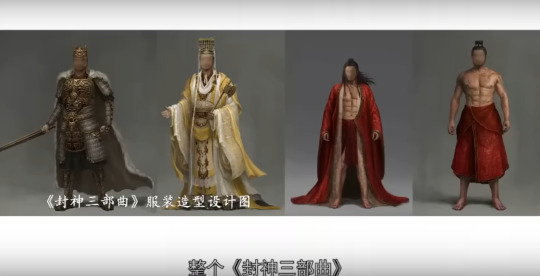
Oh this is cool I think they are sculpting Lei Zhenzi here.

And other monsters.
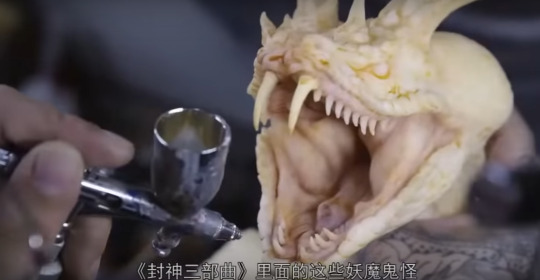
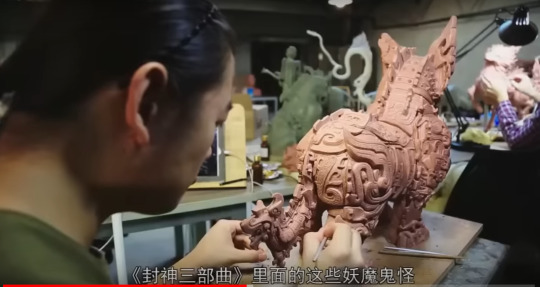
The concept artist Siji said that he appreciated that the concept artists were given enough time to develop and create the concept art.
I didn't even realize the fox demon had different forms. Siji was explaining that initially, the fox demon was more ghost-like, and only began to develop a form after eating enough people.
Hell yeah more monsters
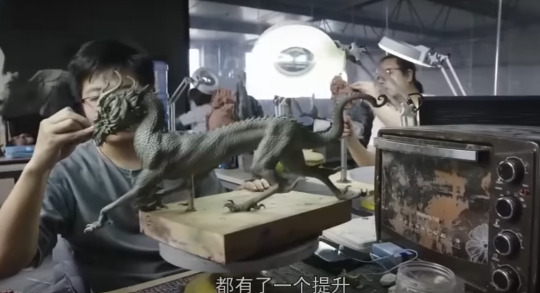
So we move on to the set and Wuershan puts just as much detail into building the set, which is very understandable. If your set is lame then it doesn't matter how beautiful your costumes are tbh. They went so far as to discuss the patterns of the beams, and what kinds of visual motifs would be on them.
Tim Yip was explaining how some of the structures they came up with would never have existed in history. But they did it for the aesthetics lol.
For some of the fight scenes, they did the storyboard by animating it in 3d because it would be easier to work with. In the example shown, the camera was constantly rotating around the character so I imagine that it would have been difficult to explain the constant motion of the camera with a normal drawn storyboard.
We got to the animation of Lei Zhenzi. The animator did a 360 view of what he would look like, and then another view where he would be carrying Ji Chang on his back, which he pointed out probably would not work if the wings were also on his back.
It looks like the entire movie was created in that Previz 3d animation system. Which makes sense. There's a lot that goes into filming and you might as well get a feel for the scenes, so that you can see if they actually deliver the intended impact.
Wu Yibei who I think is a special effects producer was talking about Lei Zhenzi. Basically it was really important for them to get all of the details of Lei Zhenzi right because he was going to be an important character in the second and third movies, and would interact with actors, would have feelings, etc.
This is super cool, this seems to be concept art for how Lei Zhenzi would have grown, how his wings would have developed as he grew up from a baby to an adult.
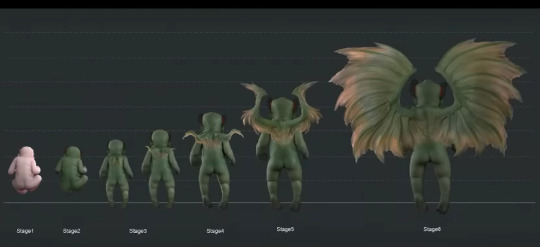
I saw this from another video that interviewed a special effects advisor for the movie. Douglas Smith had mentioned that Wuershan didn't really want Lei Zhenzi to be like a bird or a bat, and in the end, they settled for more of a fish feeling to Lei Zhenzi. Wuershan says this too in this documentary series.
Other than the physics of Lei Zhenzi's flight, I thought it was neat that Wuershan and the animators were discussing how his lightning powers would look like.
Wuershan had called up Han Pengyi and asked him if he'd wanted to be China's Andy Serkis lol. Han Pengyi served as the motion capture actor for Lei Zhenzi.
Oh wow Wuershan and Han Pengyi actually met Serkis and got to ask him about motion capture acting :o
So apparently when they animated Lei Zhenzi they hadn't really animated him blinking so Douglas Smith and team were figuring out how they could make use of other skin around Lei Zhenzi's eyes to express certain emotions.
Episode 3
Wow the craftspeople are carving the parts of the set by hand.
Look at this!!! Even just the concept art is amazing.
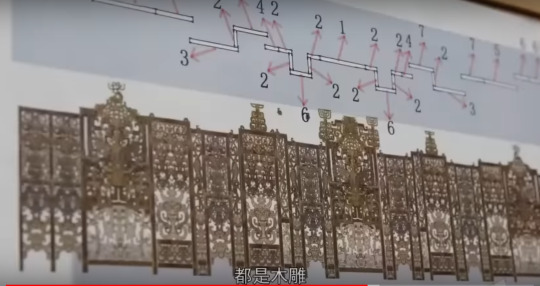
Wuershan did a lot of studying on the Lord of the Rings and consulted people who worked on that which is cool.
There was a discussion where Wuershan was discussing how the Lord of the Rings used more practical effects (in this case having a bunch of extras actually fighting in a battle) whereas by the time the Hobbit came around, they didn't consider this option anymore.
They spent a lot of time explaining how they came to film Shen Gong Bao's scene in which his head came apart from his body.
This was super blurry so I'm not going to screencap it but Ji Chang's actor Li Xuejian said "兒子演得不錯" and Wuershan patted Yu Shi's head in a 'did you hear that?' kind of way Yu Shi was all like humble like "noooo i'm not" hehe.
Apparently it was Father's day so Yu Shi wished Wuershan and Wang Yu a Happy Father's day lol.
They were trying to shoot a shot of five of the warriors on horseback jumping over a hurdle, while the horses were blindfolded. I'm not sure why the horses were blindfolded tbh but it was difficult because of that and the fact that they wanted the horses to jump together. Looked awesome though. And they got fistbump from one of the trainers for getting it done in two takes.
Taking care of the horses after a hard day's work.
Yu Shi explained that when they first started learning to ride horses, they were paired with any horse. After they got the hang of it, they were paired with a specific horse so that they could build a good relationship, and the actors would have to care for that horse too.
Ji Fa's character especially had a special relationship with his horse because he was a gift from his family and a symbol of home. And we saw them filming the scene near the end of the first movie where his horse was trying to get him to wake up so that they could go home.
Archery was something that challenged Yu Shi a lot so he practised it a lot and watched videos of archers.
Check out this diagram lol. I think they were trying to explain the setting to Gordy Haab who worked on the music.
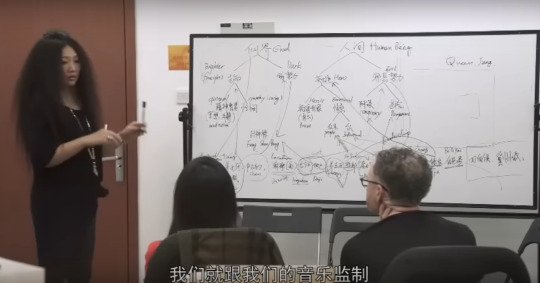
We saw Gordy checking out Chinese artifacts and listening to Chinese music. Yu Fei who was a music producer said that he had a good deal of interest in the culture.
It looks like they're having some musicians play outside at one of the sites? I'm not sure if they were actually playing though.
The male bass singers were very cool. Are they throat singing?
Looks like they're playing scenes from the movie on the screen

Me, an ex-oboist, doing the Dicaprio pointing meme to these oboists
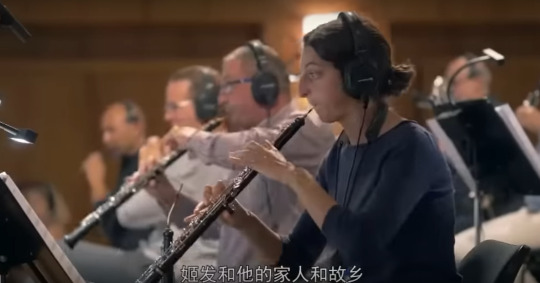
Wuershan is a fan of Penderecki. I don't know this composer so I had to look him up.
Wuershan delivering flowers to the various cast members :3
What a fun series!!!! I have some other behind the scenes videos to watch relating to this movie so I am excited :3
10 notes
·
View notes
Text
Most people know Joseph Jacobs for his work of collecting and putting in a literary form the traditional fairy tales of England - he is the man that made famous tales such as Goldilocks and the Three Bears, The Three Little Pigs, Jack and the Beanstalk, Tattercoats, The Buried Moon, and many others.
But what people tend to not know is that he was also the author of a very particular book called “European Folk and Fairy Tales” - sometimes shortened as Europa’s Fairy Book (in reference to the Fairy Books of Andrew Lang). Remember what I said before about the folklorist vs literary theories when it came to fairy tales? Well Joseph Jacobs lived in the full “folkloric fairytale” movement, fashion and study, and one of the main beliefs of this movement was that, beyond all the local and regional variations of a fairy tale, at the root of these similarly “cousin tales” found in numerous countries and eras, for each “fairy tale type”, there was an “ancestor-tale”. A “first” tale, a “primitive” tale, an “original” tale from which all the variants were born - a common ancestor that gave birth to all the different variations that formed together a “type”. It was the theory of evolution if you want, with each individual belonging to a larger group of species all coming from a common ancestor.
And Joseph Jacobs, working on this theory and belief, decided to create his European Folk and Fairy Tales book. After collecting as many variants and variations of some fairy tale types across as much European countries as he could, he compared them, studied them, and tried to re-create the “original tale”, the “ancestor-fairytale”, the “original Europan story”. The result of this work was his “European Folk and Fairy Tales” book, a book contaned the supposed and believed reconstructed “original” tales that formed the “primordial” group of fairytales from which the ones collected by Grimm, Asbjørnsen and Moe, Jacobs himself and others came from.
Of course, this being a purely folklorist work that tried to ignore as much as it could all the literary side of fairytale history (for example Jacobs removed the fairy godmother from his Cinderella reconstruction due to it being an invention of Perrault), and a work of 1916 that was created with the resources and perceptions of the time, this is not at all considered to be a true scholar work today, and it mostly fell into obscurity as an entertaining project and an interesting piece of fairytale history. But it shouldn’t be forgotten by any means, since this book reflects the beliefs and theories of the folklorists and fairy tale critics of the 1910s Western Europe, and even today on the Internet you will see several illustrations created for this specific book reused for other fairytales (I was surprised to discover that a recurring illustration of Hansel and Gretel I saw everywhere was actually created for Jacobs’ reconstruction-tale).
So if you ever want to check Jacobs’ Europa’s Fairy Book, you’ll find in it...
... The proto-”Snow White” fairytale, simply titled Snowwhite
... The proto-”Cinderella” story, Cinder-Maids
... “Beauty and the Beast”, which as you can guess is the reconstruction of the “original Beauty and the Beast”
... Thumbkin, the supposed “ancestor” of the Tom Thumb tales.
... The Unseen Bridegroom, the artificial ancestor of all “Cupid and Psyche” type of fairytales
... Johnnie and Grizzle, a synthesis of all Europan “Hansel and Gretel” stories
... The Earl of Cattenborough, the proto-”Puss in Boots”.
And many more artificial but fascinating wonders!
(Though don’t get me wrong - I do not use “artificial” in a pejorative way. Many fairytales we know today are “artificial” in the eyes of folklorists - all literary fairytales for example, from Perrault to Andersen, are demmed “artificial” by their literary nature ; and even the folklorists have to admit that some of their own created artificial tales, such as those born of the Grimm’s editing of the collected folktales. So, considering all that, while Jacobs’ reconstruction are certainly not THE actual proto-fairytales - if such a thing even exists - it is not because they are artificial that they are less to be considered than literary works or the edited final Grimm stories)
#fairy tales#fairytales#joseph jacobs#europa's fairy book#european folk and fairy tales#joseph jacobs' european folk and fairy tales#european fairy tales#fairytale types
18 notes
·
View notes
Text
so is there any actual, quantifiable evidence for multiverse theory or is it just the result of some guy with an esoteric degree going "wouldn't that be cool"? because don't get me wrong it's a cool as hell concept, but given how i'm not a quantum physicist and i'm pretty sure none of the actual proponents of the theory i've personally talked to were either i've gotta wonder if it's just some kinda pop science thing so far removed from its original context that it's basically meaningless at this point. like obviously quantum theory is real, i'd seriously doubt that quantum computers would physically function if it didn't... ok so tangent, this is a bit of an obscure story, but the guy who designed the tommy gun didn't really understand the science behind designing guns and the operating mechanism he came up with was pseudoscientific bullshit, but by sheer luck he managed to make a functioning gun, albeit with the simplest, most primitive possible operating mechanism. either quantum theory is real, or quantum computers were designed like that, and something tells me that quantum theory's probably real because computers are a lot more complicated than guns. there's a reason one's been around for about a hundred years and the other's been around for about a thousand, y'know.
anyways this got away from me and i really hope this doesn't come off as anti-intellectual, but the last time i asked somebody about multiverse theory they recorded a little video where they drew lines and said that it was a representation of dimensions beyond 3d, but when i asked what that meant they couldn't really come up with an answer. like they didn't even grasp at straws like a conspiracy theorist would, they just sorta went "huh, yeah i dunno man". i'm fully willing to accept the possibility that it's real and that i've just encountered amateurs at this point, i know that someone explaining something ineffectively doesn't actually mean it's false, i just haven't seen any Actual Scientist talk about it as anything more than a thought experiment.
i actually recently watched an almost 8 hour video about flat earthers, and i think it definitely increased my scientific knowledge. i honestly didn't know the actual definition of theory vs law in scientific jargon as opposed to the common use meaning, i just knew that there was in fact a difference and that they're a lot more rigorous than when some guy on the internet says they have a theory about a piece of fiction. it gave me a lot to think about. to my current understanding, a theory is something in science that tries to explain why things are the way they are, while a law is just an explanation of how things are. the difference being is that the law of gravity is just an observation of how the universe functions, meanwhile a theory would be trying to understand why the law of gravity functions how it does. now, i've always heard it either described as some variation starting with either many worlds or multiverse and ending with theory or interpretation. now, given how scientists at the very least consider it to have the legitimacy to refer to it as a theory (at least sometimes), i'd assume that on some level it actually explains something. i think it's also a decent assumption to make that i don't know nearly enough about quantum mechanics to understand what it's even trying to explain, so i dunno. i'm probably missing something. i feel like if i try to research into this enough it's eventually gonna get into math, and me and math go together about as well as water being tossed in boiling oil. i'm definitely a layman, so please lemme know if i got something wrong/how stupid of an idiot i am! anons are on for a reason, after all
3 notes
·
View notes
Text
Stargate rewatch: 1x09 Thor’s Hammer
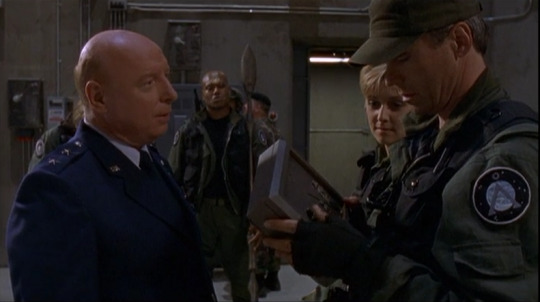
"We don’t think the Goa’uld built the Stargate system” - episode 9 of season 1 and we’re already tapping into a huge part of the mythology - the show really hit the ground running with its lore.
But who is “we”? It’s never really established whether Daniel is in charge of his own team or runs his own department, but I think we can assume so? I like to think Barbara Shaw from the film is on the team at the very least.
However the “tyrant” gods being mostly from non-white cultures and the “culture-bearers” being mostly from white/western cultures is an ongoing yikes of the show.
I wouldn’t really characterise the Norse gods as particular friends to humans? I mean in the mythology they're not tyrants but they seem no less capricious than the Goa’uld-coded pantheons. Although I guess there is some interesting stuff around the Norse gods being more like higher beings as opposed to all powerful deities, which works in the show's presentation of the Asgard, but is hardly unique to Norse myth.
For example Odin (who I don't think we ever see on the show) being more of a hands off kind of god, who is not innately omniscient but himself pursues knowledge, hanging upside down from Yggdrasil and sacrificing an eye to obtain wisdom - and of course, the fate of the gods to die in Ragnarök, an acceptance of mortality that does fit the Asgard rather than the Goa'uld.
SGC Earth has a “Sagan Institute” - a nice tribute to Carl Sagan who died a year before the show was made. IRL The Carl Sagan Institute was established in 2014.

While the hammer is obviously meant to depict the death of a symbiote, it's also likely a reference to the Midgard/World Serpent. Although the Goa’uld are referred to as “Ettins” (Eoten/Jötunn) in this episode, Jörmungandr was the serpent who surrounded Midgard (Earth) eating its own tail, and was Thor’s enemy.
It’s Gairwyn! I love Gairwyn so much. Played by Tamsin Kelsey, who was also a big figure of my childhood as Evie O’Hanlon from the tv movie Yes Virginia, There is a Santa Claus.
"You must be from Thrudvang, Thor's home in the stars." Þrúðvangr was the realm of Thor and the location of his great hall Bilskirnir, which in later episodes will be identified as Asgard Thor's flagship.

“You and I might even have some of the same ancestors” - Sam has Scandinavian heritage I suppose?
Hologram!Thor is Mark Gibbon, who will go on to play a recurring Jaffa role in later seasons.
Thor of course is the obvious choice for Supreme Commander of the Asgard fleet - we get a quick mythology primer from Daniel at the top of the episode and it's funny to think that would probably be unnecessary now given the Marvelisation of pop culture. But if there was a Norse god who could be considered a "friend to humans" like Daniel claims, it would be Thor.
“The High Council of Asgard has designated Cimmeria a safe world for developing sentient species, by unanimous decree 40.73.29. The Goa’uld system lords were so informed.” So is Cimmeria part of the Protected Planets Treaty? I assume so, but that Thor doesn’t trust the Goa’uld and installed the Hammer just in case. His message is kind of sassy too, we get the impression later that Thor is perhaps more invested in humanity than the other Asgard, and would take action against the Goa’uld if he could. So it makes sense his pet planet would have extra protection.
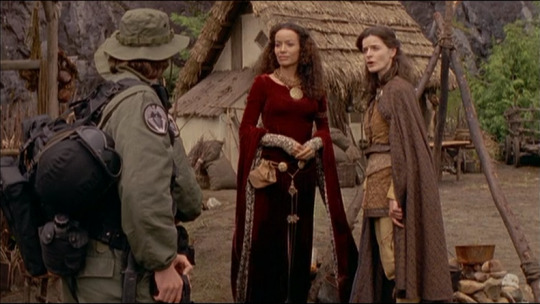
Galyn Görg (RIP) is wonderful as Kendra, it’s a shame she doesn’t recur.
What a Look too, fantastic costuming this episode - Gairwyn's is great as well.
And two women in major supporting roles! Another Katharyn Powers episode, this is one I really love.
The first proper appearance of the healing device.
Also the helmets are still with us - just attached to their backpacks.
“[Thor’s] race may have considered projectile weapons too primitive to be concerned about.” Heh. I love that this comes back into play with the Asgard vs the Replicators later on.
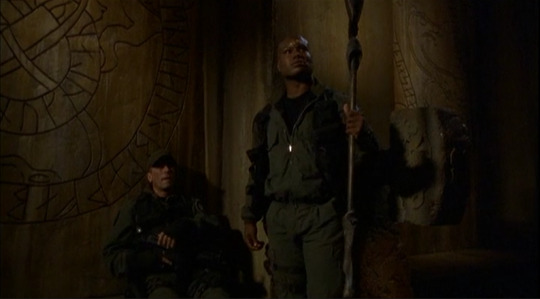
I think this the World Serpent on the wall behind Jack as well, in a more expansive form than was on the Hammer.
There’s another layer to this in hindsight - when Jörmungandr releases its tail from its mouth, Ragnarök will begin, and he and Thor will kill each other. Ragnarök is Götterdämmerung - the twilight of the gods. By the end of the series the time of both the Goa’uld and the Asgard will have passed, although not due to direct conflict between these two races, but rather the ascendancy of Midgard/Earth.
Jack is pretty subdued when Teal'c points out the Hammer could be used to free Sha're and Skaara - I think he's already figured out that they'll probably have to destroy the Hammer to get Teal'c out so won’t allow himself to think about the what ifs.
James Earl Jones! Everything is better with James Earl Jones.
“Unas is believed to have been the first host, born of the same primordial waters as the Goa’uld.” Although Unas is later revealed to be a race rather than a single being, the continuity of this in season 4 is great.
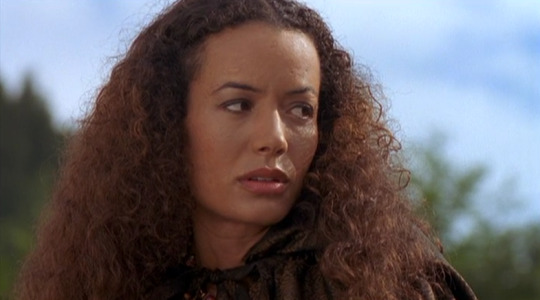
Kendra doesn’t say the name of the Goa’uld who possessed her, but mentions Marduk as the one who abducted her, which may present a continuity problem later as Marduk is trapped in a sarcophagus and only freed in season 4. But I suppose it’s not clear how long exactly Kendra was a host.
“Well Sha’re wasn’t trained in a temple like you, but she had a spirit, she was a fighter.” As we saw in CotG. Daniel's unwavering faith in Sha're fighting against the possession says a lot about their relationship.
But one of the failings of the show is that it is supremely uninterested in the trauma of Goa'uld possession - we get a bit with Sam although that becomes more about Jolinar's memories and the blending of the symbiote and host, and kind of with Vala later but it’s really only treated as a shorthand for why she is the way she is.
With Kendra we at least see how her trauma manifests in her isolation, her talking to the wind, interpreting the thunder, and ultimately deciding to face her fear.

This is a nicely directed episode too, by Brad Turner, who will helm several future episodes. Some really nice shots of Kendra, Daniel, and Sam climbing over mountains and walking over aqueducts.
Sam the skeptic vs Daniel the optimist. She’s actually pretty hard on him here! I’m not sure what Sam thinks their other options are if they don’t follow Kendra.
If Daniel’s flaw is his hubris and tendency to fixate at the expense of all else, Sam’s is her judgemental streak and unwillingness to think outside the logic box.
“Haven’t you ever had a feeling that made absolutely no logical sense and it turned out to be right?” The answer for Sam is clearly no, but that will change as part of her character arc will be sometimes learning to trust things that can’t be quantified.
And its helmet time.
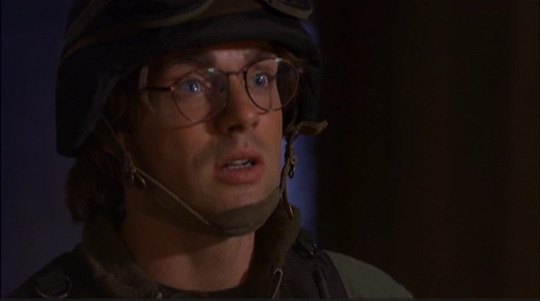
"I was with those who took the ones you love." A little bit of mitigating language on Teal'c part, but his willingness to remain trapped just on the chance that the wrong he was party to can be righted, we can see how much guilt he does feel. I still wish we'd actually gotten a scene before this between Daniel and Teal'c about Sha're.
Jack having Daniel be the one to destroy the hammer is harsh, but it has to be Daniel. Because he is the one most affected by the decision, he needs to be the one who makes it, not have it be made for him. Importantly, Jack doesn’t order him to do it, and isn’t completely sure he will, just hopes.
By being the one to fire the shot, Daniel takes ownership of it, and it avoids resentment on his part - Jack knows that it’s the way it has to be for Daniel personally, and the good of the team.
To his credit once handed the staff weapon Daniel doesn't hesitate - closing his eyes before firing is a nice touch though.
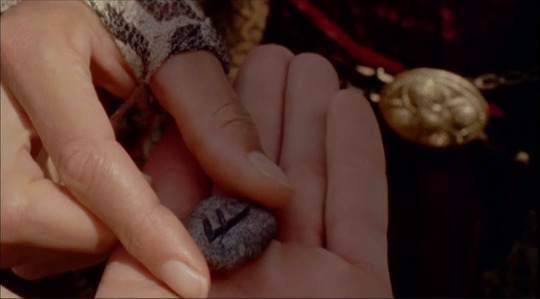
Kendra gives them the Ansuz rune, the equivalent to A in Elder Futhark, meaning god and is associated with Odin, knowledge and communication.
#stargate sg1#stargate rewatch#1x09 thor’s hammer#jlf posts#norse mythology#meta#daniel jackson#sam carter#jack o'neill#teal'c#stargate sg-1#jlf watches stargate
11 notes
·
View notes
Note
Someone recently told me that British and American fans of JCS have different preferences and I’ve been thinking about that a lot. So what differences do you know of? If you’re American or British what is your reaction to American vs. British productions you’ve seen? What about the original album which has a mix of British and American artists working together? I’m American, but I realized I think of JCS as primarily a British show, so perhaps my preferences lean toward British.
This... is a fantastic question. I apologize that my answer is not nearly as brief.
I feel that Danny Zolli (who has frequently played the roles of Jesus, Judas, and Annas over the years) sums it up best in his interview for our website, referring to the 2000 Broadway revival:
The Broadway production was, in my opinion, a very English-style production of the show. American audiences don’t tend to respond to that very well. American audiences want their Jesus and Judas to be willing to cough up a lung for them in the course of the show. It’s called “the Passion” for a reason — there has to be passion within the actors and actresses performing the roles to give the story its justice.
Maybe my years of voracious JCS consumption have been colored by that opinion somewhat, but I would tend to agree that's the main difference. The next question is why.
Well... in America, the concept album took off like a rocket. It's an icon right up there with Sgt. Pepper in the minds of many people who lived through the era. Such classics as “Heaven on Their Minds,” “Everything’s Alright,” “I Don’t Know How to Love Him,” and “Superstar” racked up frequent radio airplay in their own right. The show’s earliest live success here came in the form of a concert tour (three of them, actually, hastily assembled to beat an already enormous band of pirates), not a theatrical run. Moreover, those early stage productions -- and the 1973 film -- were not a vast departure from that initial sound: raw, imperfect, rough, a little primitive, like the best of classic rock.
Overseas, however, the album did not sell the show. In England, the show only became successful once it was running in the West End, at one point becoming the longest-running musical in British history; in many European countries, the show is remembered much more fondly because of the film or because of the first major premiere in their neck of the woods. (In Spain, for example, it is incredibly difficult to separate JCS from the fact that it began life there as a Camilo Sesto vehicle. He's the benchmark like Ted Neeley or Ian Gillan would be for many English-speaking fans, and they just did a Fosse/Verdon-like TV series about his production over there that was a smash.)
Consequently, when Andrew Lloyd Webber looked back on the show once he controlled the rights, he was able to try to make it more like his later work: acrylic slickness and polish, some adjustments to the orchestrations, some revised lyrics from Tim Rice. It was more about the acting and less about the music, more of a theater piece and less of a rock show, and he put a lot of time and effort into making it so, putting that stamp on the first West End revival in 1996 and each production that followed.
Without weighing in on which version I prefer, I'll simply say there's a distinct difference between major JCS productions before and after 1996 that owes much to ALW's influence, and that's probably what your friend is referring to.
#jesus christ superstar#andrew lloyd webber#tim rice#jcs#show questions#ted neeley#ian gillan#camilo sesto#danny zolli
6 notes
·
View notes
Text



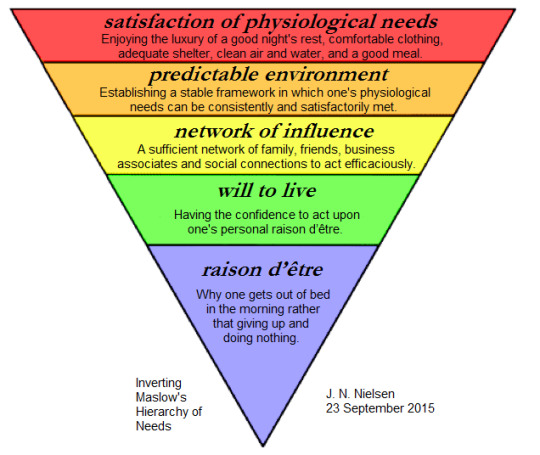
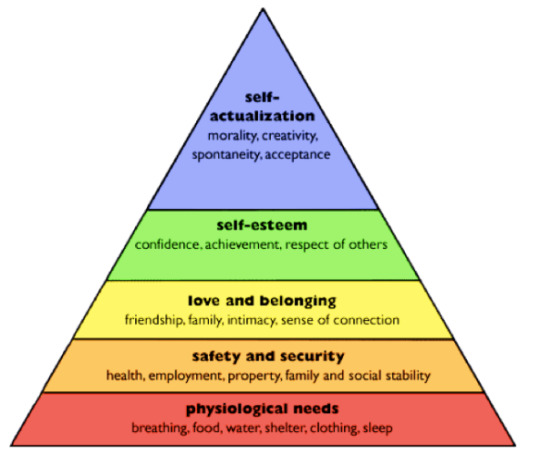





All
Images
Videos
Short videos
Shopping
Forums
Books
Web
News
Maps
Flights
Finance
Search tools
Feedback
Search Results
AI Overview
AI Overview



+4
Sigmund Freud's theory, while often referred to as a psychosexual theory, emphasizes the development of personality through stages focused on unconscious drives and early childhood experiences. These stages, which include oral, anal, phallic, latency, and genital, are characterized by different erogenous zones and potential fixations if needs aren't met.
Here's a more detailed breakdown of Freud's key ideas:
Core Concepts:
Unconscious Mind:
Freud believed that a large part of our thoughts, feelings, and motivations are unconscious, influencing our behavior and personality.
Id, Ego, and Superego:
Freud proposed that the personality is composed of three structures: the id (primitive instincts), the ego (reality-oriented), and the superego (moral compass).
Psychosexual Stages:
Freud theorized that personality develops through a series of stages, each with a specific erogenous zone and potential conflicts that can lead to fixation if unresolved.
Oral Stage (birth to 1 year): Pleasure focused on the mouth (sucking, eating).
Anal Stage (1 to 3 years): Pleasure focused on bowel and bladder control.
Phallic Stage (3 to 6 years): Pleasure focused on the genitals, Oedipus/Electra complex.
Latency Stage (6 years to puberty): Sexual feelings are repressed, focus on social skills.
Genital Stage (puberty to death): Sexual feelings reemerge, focus on relationships.
Key Takeaways:
Early Experiences Matter:
Freud emphasized that early childhood experiences and how conflicts are resolved during these stages significantly impact personality development.
Fixation:
If a person experiences too much or too little gratification during a particular stage, they may become "fixated" at that stage, leading to certain personality traits or behaviors later in life.
Defense Mechanisms:
Freud also proposed that individuals develop defense mechanisms to protect themselves from anxiety and unconscious conflicts.
Freud's Stages of Human Development: 5 Psychosexual Stages
Jan 29, 2025 — Overview of Freud's Psychosexual Stages of Development ... Freud believed that personality developed through a series of childhood stages in which t...

Verywell Mind
Freud vs. Erikson's Theories of Development | Overview & Stages
Freud was a neurologist treating patients in his young medical practice when he began developing his groundbreaking theories about personality and human develop...

Study.com
Psychodynamic Theory: Freud – Individual and Family Development ...
What he proposed was that unconscious motives, desires, fears, and anxieties drive our actions. When upsetting memories or thoughts begin to find their way into...
Iowa State University Digital Press
Psychosexual Development: Breakdown of Freud’s 5 Stages
Jun 7, 2023

Verywell Health
Psychosexual and Psychosocial Theories of Development
Psychosexual Theory of Development Sigmund Freud (1856–1939) believed that personality develops during early childhood. For Freud, childhood experiences shape o...

Lumen Learning
Freudian Psychology: Sigmund Freud's Theories and Ideas
Apr 2, 2024 — Sigmund Freud's Theory of the Psyche ... Freudian psychology compares the mind to an iceberg. The tip of the iceberg that is actually visible above t...

Verywell Mind
A Comparison of Freud and Erikson's Theories of Development
Feb 16, 2025 — Freud's Theory The first stage of psychosexual development is known as the oral stage. 1 At this point in development, a child's primary source of p...

Verywell Mind
Psychosexual theory by Sigmund Freud | PPT - SlideShare
Jun 3, 2021 — Sigmund Freud believed that children progress through multiple psychosexual stages of development from birth through adulthood. These stages include ...

SlideShare
Sigmund Freud in Early Childhood Education: A Practical Guide
Oct 21, 2024 — Freud believed that the unconscious mind plays a crucial role in shaping our thoughts, feelings, and behaviours. He argued that early childhood expe...

Early Years TV
Freud's psychosexual development | PPT - SlideShare
Dec 12, 2012 — Freud's theory of psychosexual development proposed that adult personality is shaped by early childhood experiences through five psychosexual stages...

SlideShare
Freud's Theories - Penn State World Campus
Freud's Psychosexual Theory of Development ... Puberty reawakens sexuality! According to Freud, children pass through a series of stages, where at each stage th...

Penn State World Campus
Sigmund Freud's Psychoanalytic Theory of Personality - Lesson
There are three parts to the personality according to Sigmund Freud's psychoanalytic theory. These are the id, superego, and ego. The id is the first to develop...

Study.com
Generative AI is experimental. Learn more
Export
Save
Featured snippet from the web



View all
Originating in the work of Sigmund Freud, the psychodynamic perspective emphasizes unconscious psychological processes (for example, wishes and fears of which …

https://iastate.pressbooks.pub
Psychodynamic Theory: Freud – Individual and Family Development ...
… proposed that personality development in childhood takes place during five psychosexual stages, which are the oral, anal, phallic, latency, and genital stagesMar 13, 2025

https://www.simplypsychology.org
Freud's Psychosexual Theory and 5 Stages of Human Development
… the conflicts between the id, ego, and superego happen throughout a person's life, but the results of those conflicts change as a person moves from child to …

https://study.com
Freud vs. Erikson's Theories of Development | Overview & Stages
Feedback
About featured snippets
People also ask
What is the psychosocial theory of Sigmund Freud?
What is the psychological theory of Sigmund Freud?
What are the 5 stages of psychosexual development theory of Sigmund Freud?
What is the difference between Erikson and Freud?
Feedback
Web results

Verywell Mind
https://www.verywellmind.com
Freud's Stages of Human Development: 5 Psychosexual Stages
Jan 29, 2025 — Freud's Stages of Human Development ; The Oral Stage · : Birth to 1 Year · : Mouth · Trust vs. Mistrust: Psychosocial Stage 1 ; The Anal Stage · : 1 ...

UCF Pressbooks
https://pressbooks.online.ucf.edu
Psychosexual and Psychosocial Theories of Development
According to psychosocial theory, we experience eight stages of development over our lifespan, from infancy through late adulthood.
People also search for
Sigmund Freud psychoanalytic theory
Sigmund Freud psychosexual stages
Erikson theory of psychosocial development
Sigmund Freud theory
Freud stages of human development
Psychosexual theory PDF

Sigmund Freud
Austrian neurologist
Books
Education
Web results

Verywell Mind
https://www.verywellmind.com
Freudian Psychology: Sigmund Freud's Theories and Ideas
Apr 2, 2024 — ... psychosocial theory places more emphasis on one's environment. Erikson's and Freud's theories also vary in terms of stages of development.
Images

Freud's Stages of Human Development: 5 Psychosexual Stages

Simply Psychology

Freud's Stages of Human Development: 5 Psychosexual Stages

Simply Psychology

What Are Sigmund Freud's Theories? Sigmund Freud's Theories ...

Outlier Articles - Outlier.org

Sigmund Freud's Psychosexual Stages of Development - The ...

The Psychology Notes Headquarters
More images
Web results

Verywell Health
https://www.verywellhealth.com
Psychosexual Development: Breakdown of Freud's 5 Stages
Jun 7, 2023 — Though Erikson was influenced by Freud's theories, his psychosocial theory drew both similarities and differences. Like Freud, Erikson ...

YouTube · Professor LaMarr
690+ views · 7 months ago
Ch. 1 Sigmund Freud’s Psychosexual Theory

6:03
Freud's theory of self suggests that there are three parts of the self the ID is the part of the self that is inborn it responds to biological urges.
4 key moments in this video
People also search for
Psychosocial development theory
Latency stage
Psychosexual development
Page Navigation
More search results
Footer Links
Results are personalized-Try without personalization
45404, Dayton, OH
- From your device
Update location
Terms
AI overview is ready
1 note
·
View note
Text
Sanguis Creaturae Vs Vampires
In The Stranger By The Harbour, Caspian Hitch refers to himself and ‘the others’ as sanguis creaturae… but what exactly is that? To help us out, let’s distinguish the differences between the sanguis and vampires.
(Re)birthed
To an extent, the sanguis and vampires are one in the same, but there are some key characteristics that set the two apart, one being how they are (re)birthed into the world of the undead. For the sanguis, this process is often traumatic - despite what they may say otherwise - and likely forced upon them by a being of the same species. Meanwhile, for vampires, they are quite literally born as vampires. It is an exclusive species, and the only way to become a vampire is through vampiric familial ties. In other words, through genetics. The sanguis are the only beings who are subject to a transformation. Vampires are not.
Abilities
Each species possesses a set of supernatural abilities. The sanguis, for example, are able to smell the emotional fluctuations within human blood, with each emotion being represented by a specific scent, e.g. happiness is sweet. Additionally, their bodies do not require sleep to function, as all bodily functions will pause upon transformation. However, if one finds themselves severely injured, only then will they consider resting until the injury has been dealt with. It’s true they might not be able to die by physical injury or disease, but the pain is still present, and can take a toll on a sanguis’ mental state, especially their sanity. Aside from the power to nourish themselves off of blood as well, this concludes their list of abilities. Although, for vampires… this is only the beginning.
Vampires possess these same abilities, and many more, but they are amplified and, as a result, more powerful. For example, a vampire may move at extreme speeds, to an extent that gives the impression of teleportation. Furthermore, they can utilise their extreme strength to fight with increased ease during a hunt or scuffle. But, their most powerful ability of all is the vampiric pact. Here, a vampire will seek out a sanguis and give them a task (often involving dirty work), and to help them achieve this task, the vampire will lend them a fraction of their abilities - hereby creating a form of soul-tie/pact. If the sanguis succeeds with their task, they may keep their new abilities. However, if they fail (as they often do) the vampire can punish them however they see fit. Although, the usual punishment for failure… is death.
Prejudice
The vampiric pact is but one example of the hierarchy present between the two species. Due to the exclusivity of the vampiric race, along with their heightened powers, vampires deemed themselves superior to the sanguis. Despite it not being discussed verbally, this divide is known very well across both species, with each being having their own opinion on the matter. One factor in particular that fuels the divide is the wealthy status of vampiric families, which is often the result of noble ties. Whilst vampires live in luxury, the sanguis are forced into populated, impoverished villages, towns and cities, where they can effectively hunt to satiate their hunger in minimal time. This way of life is viewed as primitive by vampires, who actively shun it.
FUN FACT : Sanguis creaturae is Latin, and roughly translates to ‘the blood of the creature' or 'blood creatures'. This name was given to the sanguis, who were previously nameless, by vampires as a way to diminish their existence. By reducing them to ‘blood’, they are essentially stating that the sanguis are disposable, and that they are only important when used to achieve something bigger, like ‘blood’ to satiate the hunger of a ‘creature’. Overtime, the sanguis gradually reclaimed this title for themselves, and became less sensitive about its origin. However, vampires still use this name in a derogatory manner, and the sanguis are very aware of this.
0 notes
Text
Noting the possible importance of carrying containers to human evolution is interesting and neat, but I honestly find the way that quote gets passed around a bit frustrating, because we actually can do a bit better than this Greek philosophy approach of trying to work out the history of tools by study of present day humans and pure reason! Tool use has been observed in chimpanzees! Chimpanzees may not be a perfect model for our own distant ancestors, but they give us a glimpse at what sort of tools an omnivorous sorta human-like smart but not human-smart primate closely related to us uses, which seems a step up from the sort of speculation you see in that quote in the OP.
Chimpanzee tools noted here:
Sticks used to fish termites out of termite mounds.
Leaves used as sponges to soak up water to drink.
Rocks used to break open gourds and nuts.
Toys!
Rocks used as weapons.
Maybe spears?
Hmm, a little bit ambiguous. But chimps and humans aren't the only primates that have tool use, so it may be illuminating to look at the even more primitive tool-kits of other primates.
Some chimpanzees do maybe seem to use spears and there are other references to animals using weapons, whereas I don't see any mention of carrying containers (the nearest thing I can find is the references to chimps using leaves as sponges to drink), which gives a point to the spear hypothesis. But spear use in chimpanzees is noted as something not documented until relatively recently and pretty unusual; they'd be the only animal other than humans known to do such a thing. Whereas I see lots of references to tool use by nonhuman animals other than chimps. What I see is a lot of other kinds of tool use that make it pretty likely that the actual answer to "was the first tool the spear or the carrying bag?" is "it was neither." Chimpanzees use stones to crack nuts and sticks to catch insects and gather honey, for instance. Orangutans also use tools for insectivory, and to help them eat a kind of fruit - and apparently sometimes as sex toys lol. Gorillas seem to mostly use tools to stabilize themselves, e.g. as walking sticks while crossing water - which I guess makes sense, being big and heavy and living in a jungle means fall injuries might be a serious problem for them.
So my bet on "was the first tool a spear or a carrying bag?" is very heavily on "it was neither, the first tool of our lineage was probably a hammer used to break nuts or a stick used to pull termites out of their mound or something like that."
Really, the whole spear vs. carrier bag argument just feels fundamentally mistaken in its model of the relationship between tools and humanity. Like it thinks the first tool was a specifically human thing and learning to use tools was some big moment in the transition from ape to human. Given how many apes seem to do some tool use, the first tool probably long pre-dated the human-chimpanzee split!
I wonder if this is just an example of science marching on. According to this, Jane Goodall first observed chimpanzee tool use in 1960 - and tool use was previously believed to be exclusive to humans. IIRC at the time somebody said that now they'd have to redefine tool, redefine human, or accept chimpanzees as a type of human, because before Goodall observed chimps doing it tool use was seen as a specially and quintessentially human thing (turned out the option we chose was to redefine "human"). "The Carrier Bag Theory of Fiction" was apparently written 16 years later, but maybe chimpanzee tool use just hadn't percolated widely into public consciousness yet?
-------
Aside: I think another important "extended phenotype of culture" thing related to infant care might be cutting and grinding food. Human babies need supplementary feeding with foods that aren't breast milk after six months or so. Our teeth don't start erupting until 8-12 months. Cutting or grinding food into a form suitable for feeding to a toothless baby may have been important in providing extra calories to fuel faster brain development early in life. Knives (that could be used to cut food into bite-size pieces that could be swallowed by a toothless person) might have been a crucial technology that enabled our brains to get so big in the first place, like fire. Early supplementary feeding would also mean more child-care could be outsourced to people who weren't lactating, like the grandparents and the father.
““The Carrier Bag Theory of Fiction,” an essay Le Guin wrote in 1986, disputes the idea that the spear was the earliest human tool, proposing that it was actually the receptacle. Questioning the spear’s phallic, murderous logic, instead Le Guin tells the story of the carrier bag, the sling, the shell, or the gourd. In this empty vessel, early humans could carry more than can be held in the hand and, therefore, gather food for later. Anyone who consistently forgets to bring their tote bag to the supermarket knows how significant this is. And besides, Le Guin writes, the idea that the spear came before the vessel doesn’t even make sense. “Sixty-five to eighty percent of what human beings ate in those regions in Paleolithic, Neolithic, and prehistoric times was gathered; only in the extreme Arctic was meat the staple food.” Not only is the carrier bag theory plausible, it also does meaningful ideological work — shifting the way we look at humanity’s foundations from a narrative of domination to one of gathering, holding, and sharing.”
—
Siobhan Leddy in The Outline. We should all be reading more Ursula Le Guin
Her novels imagine other worlds, but her theory of fiction can help us better live in this one.
There’s a link to a PDF of Le Guin’s essay here.
(via protoslacker)
16K notes
·
View notes